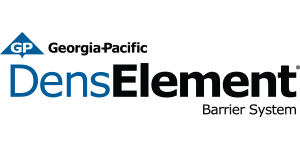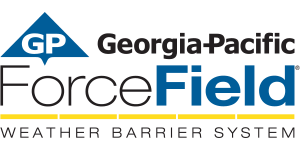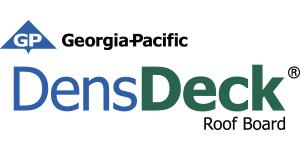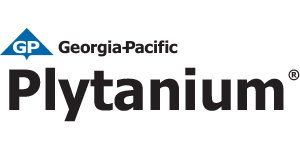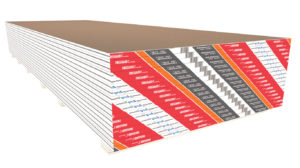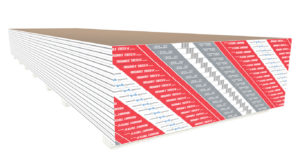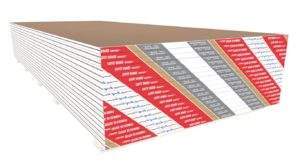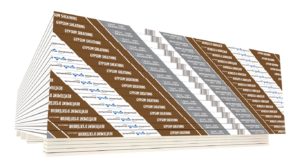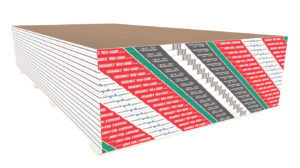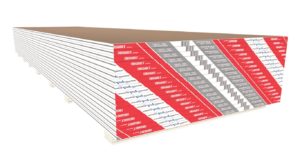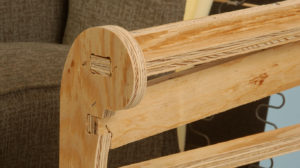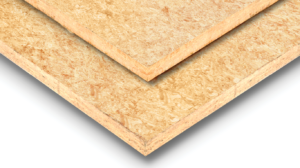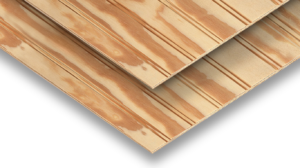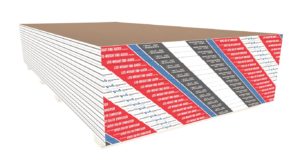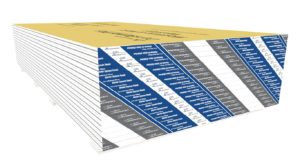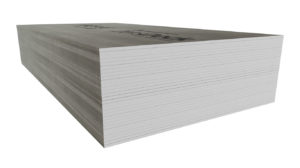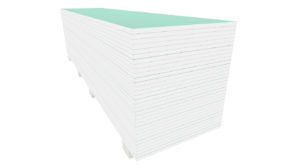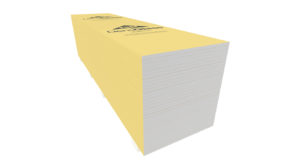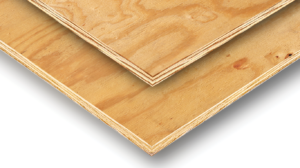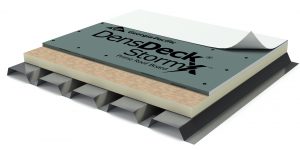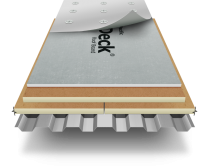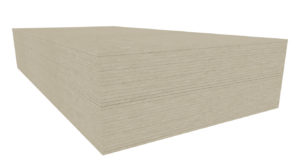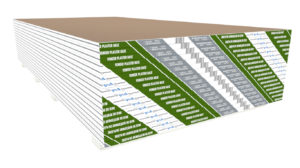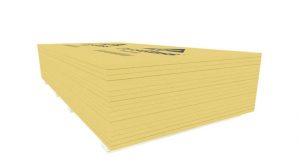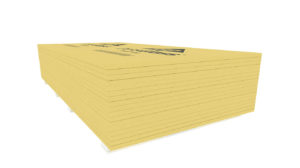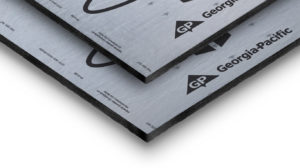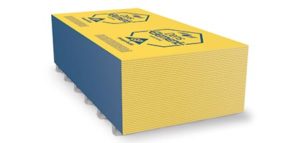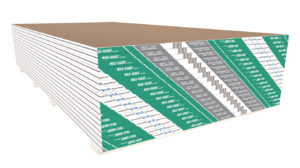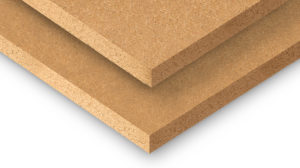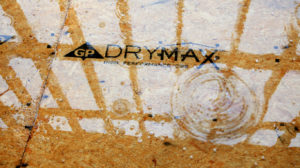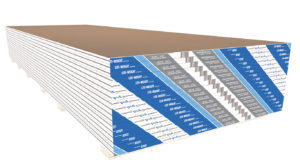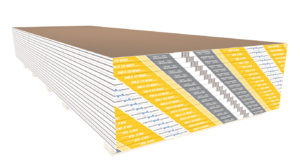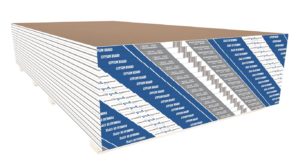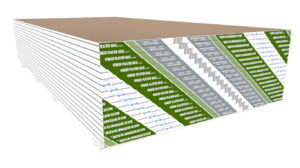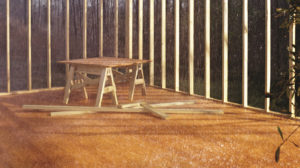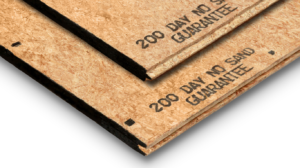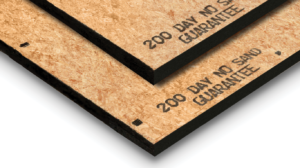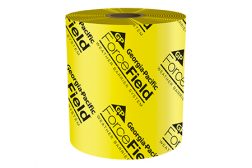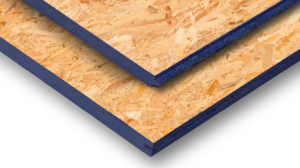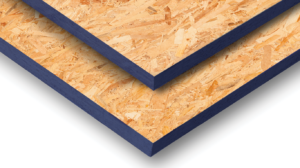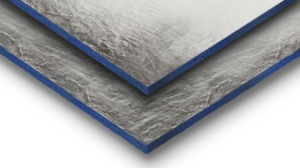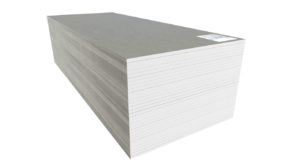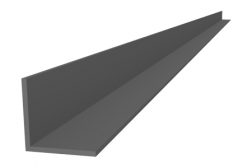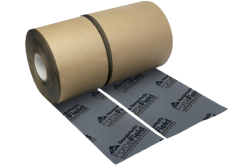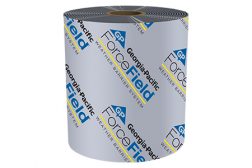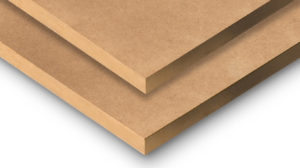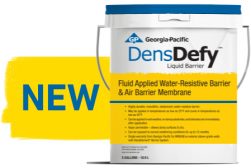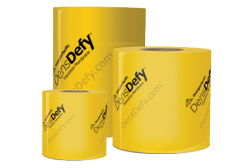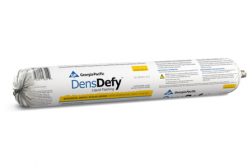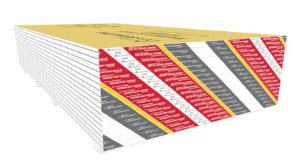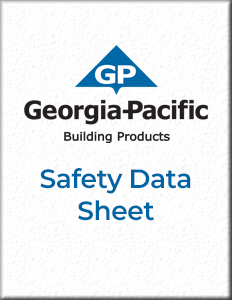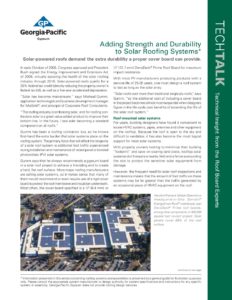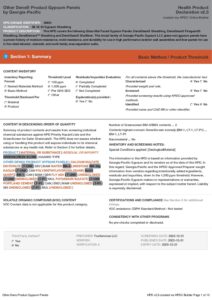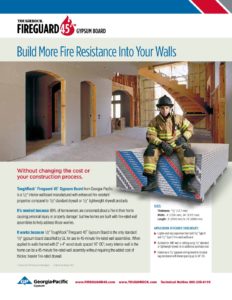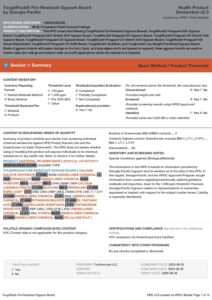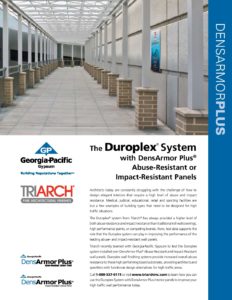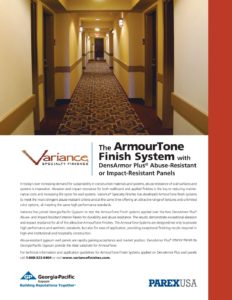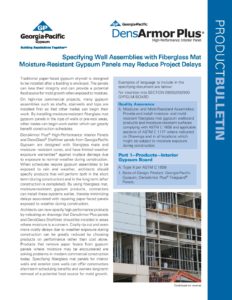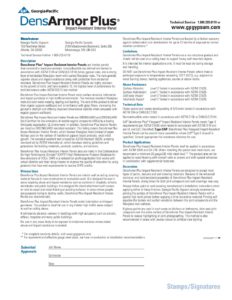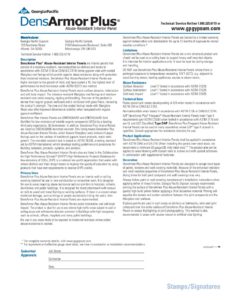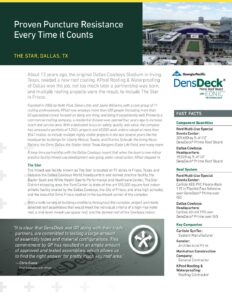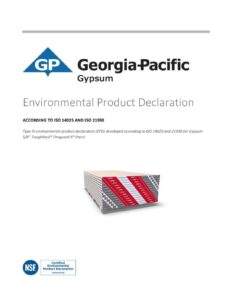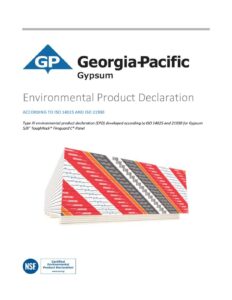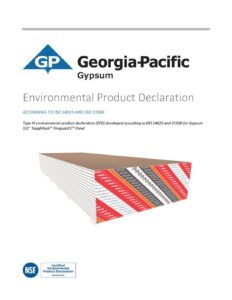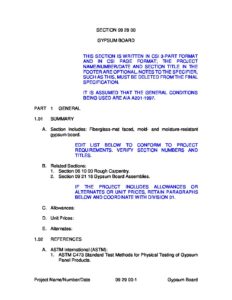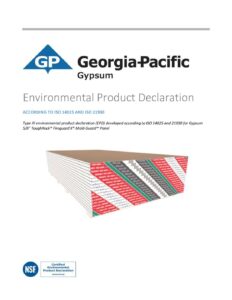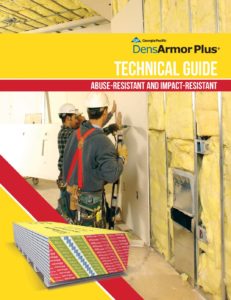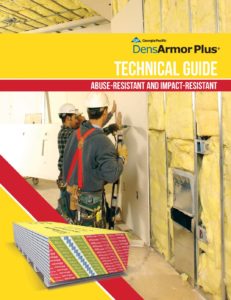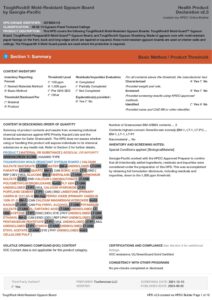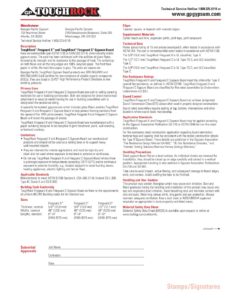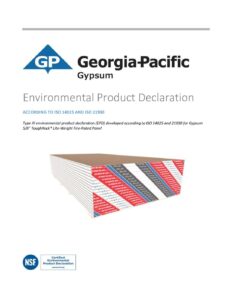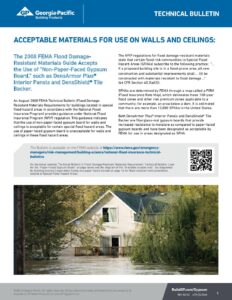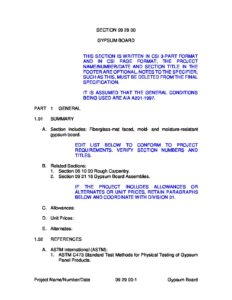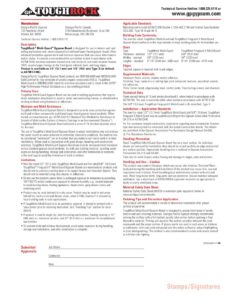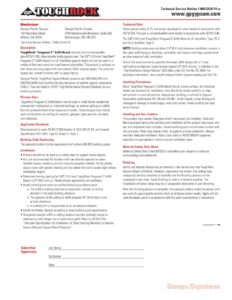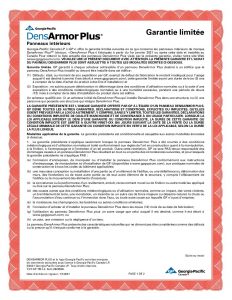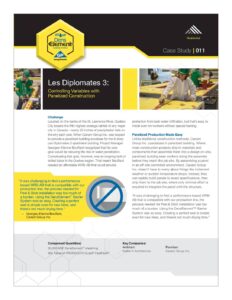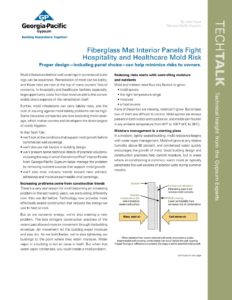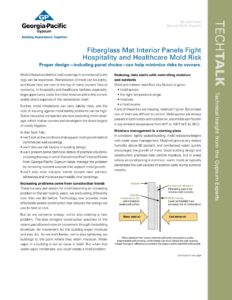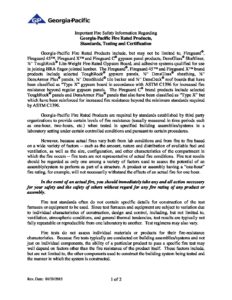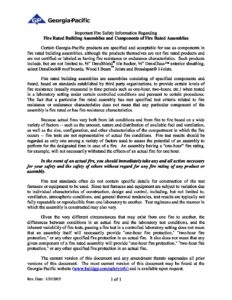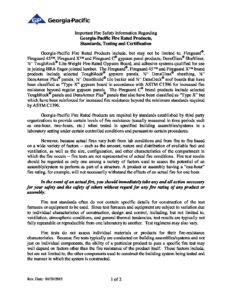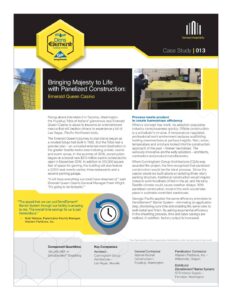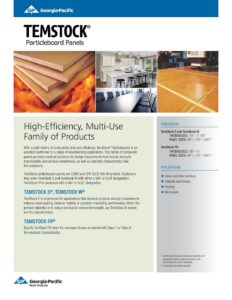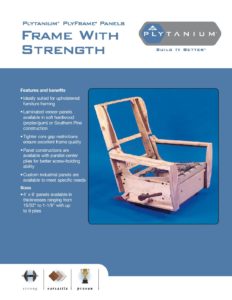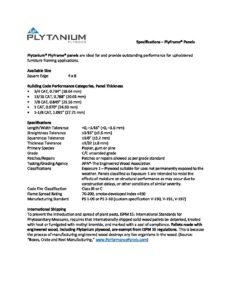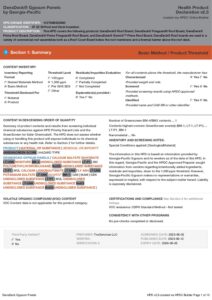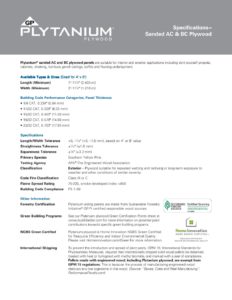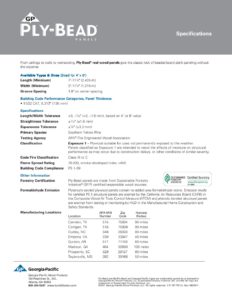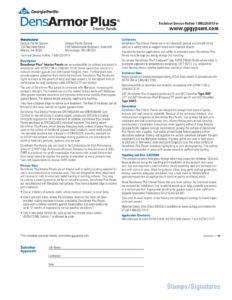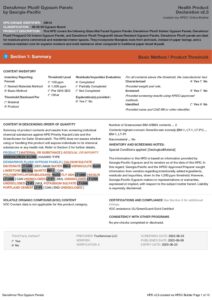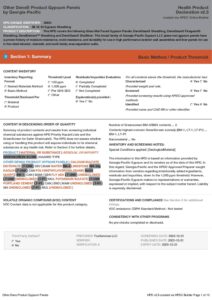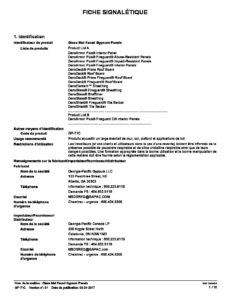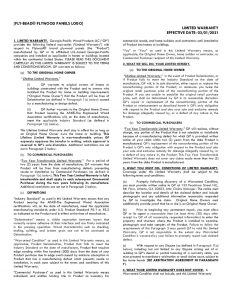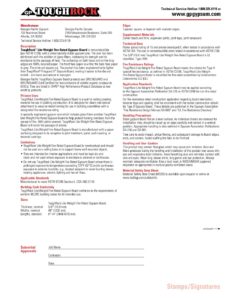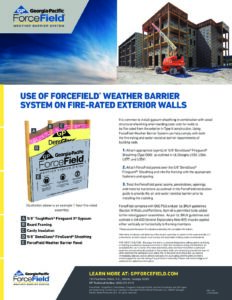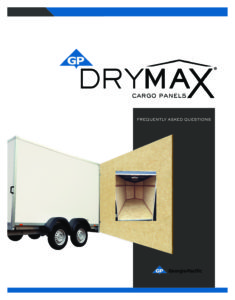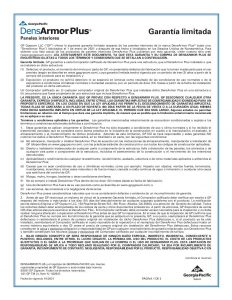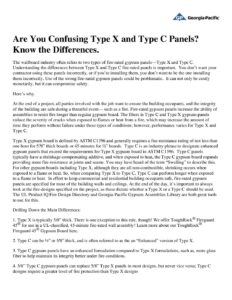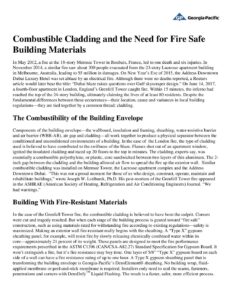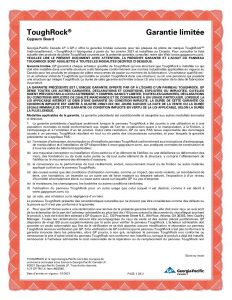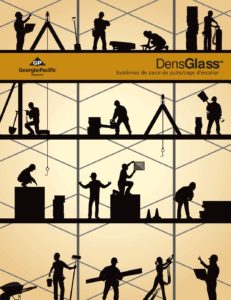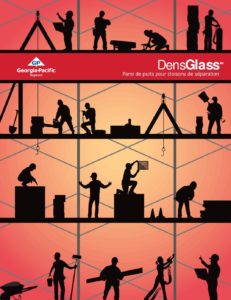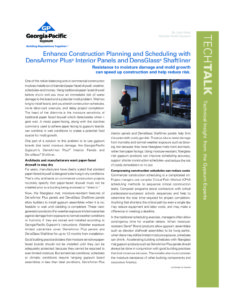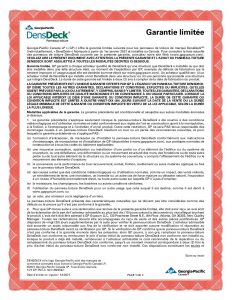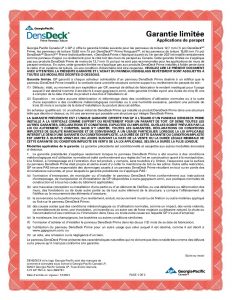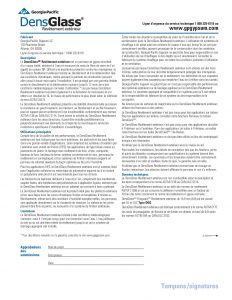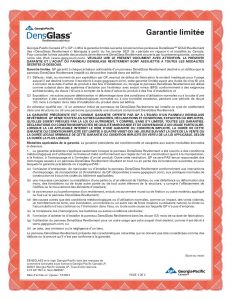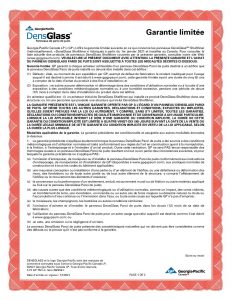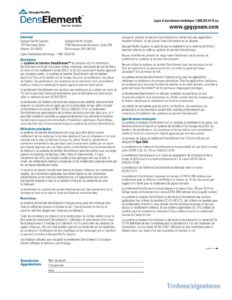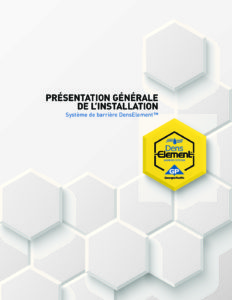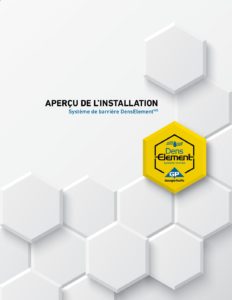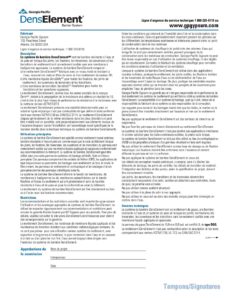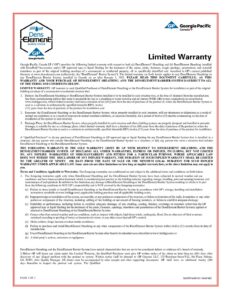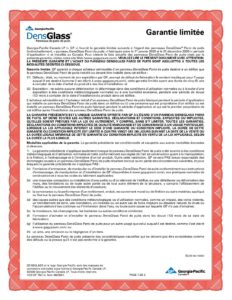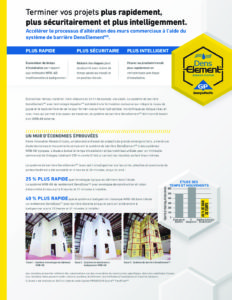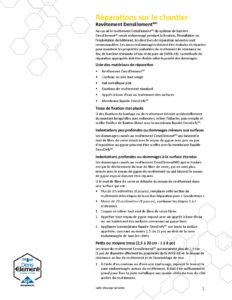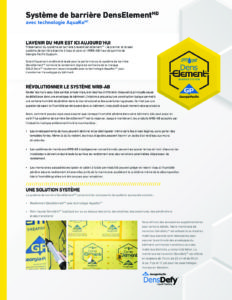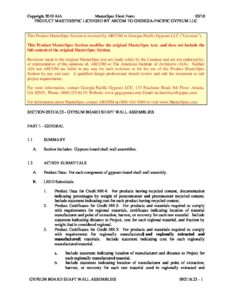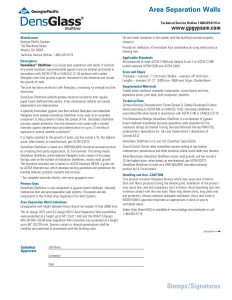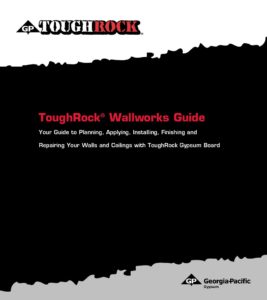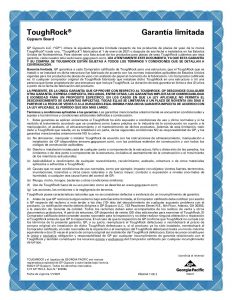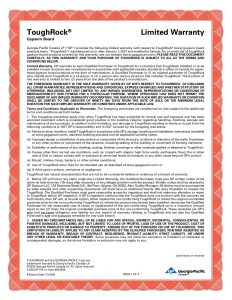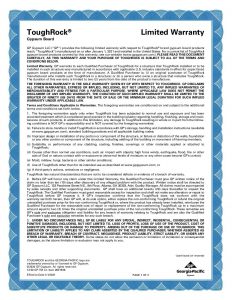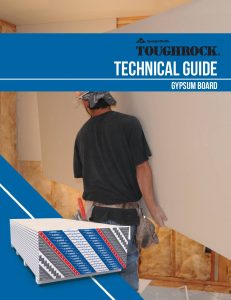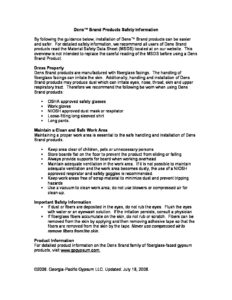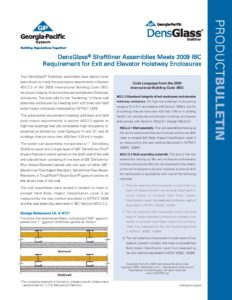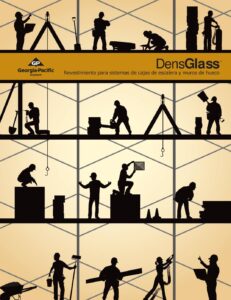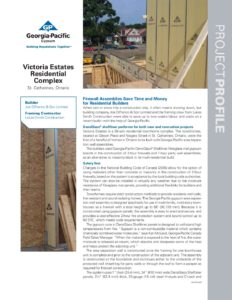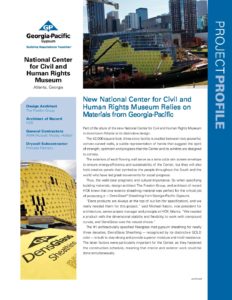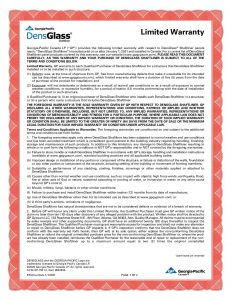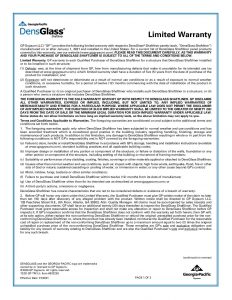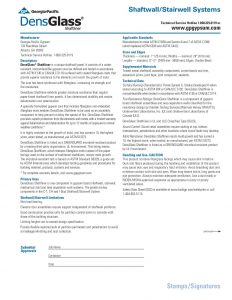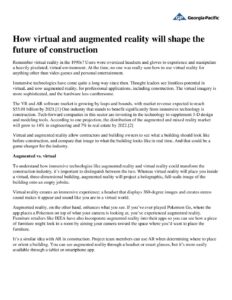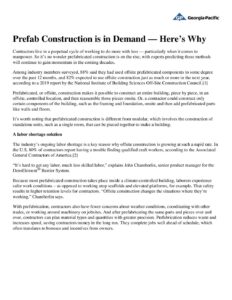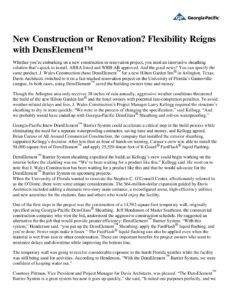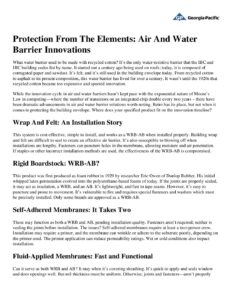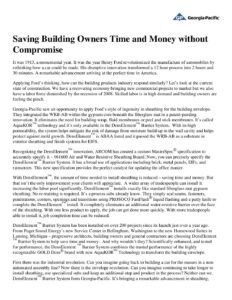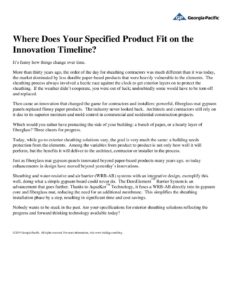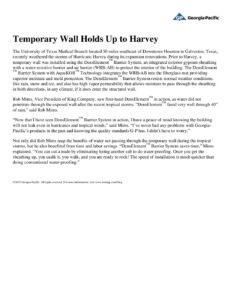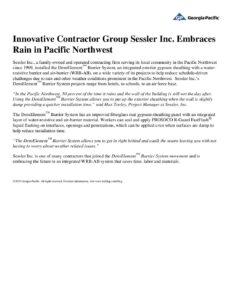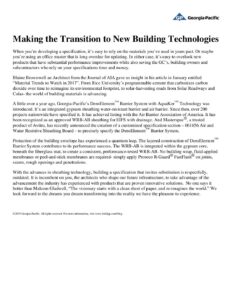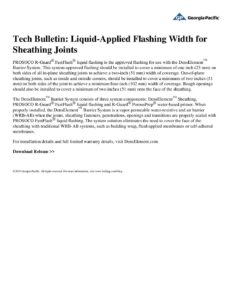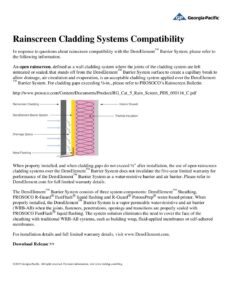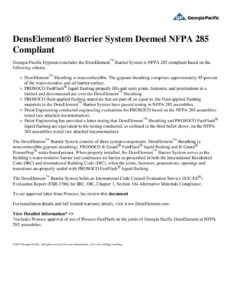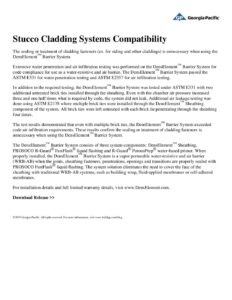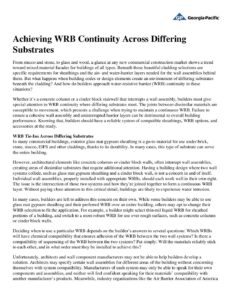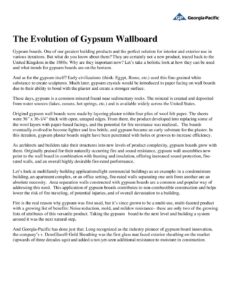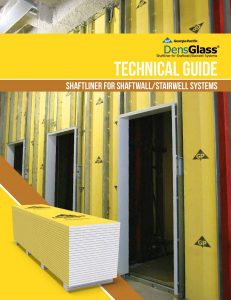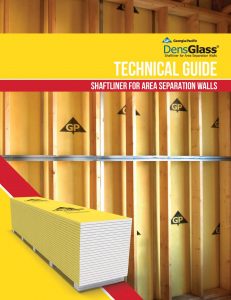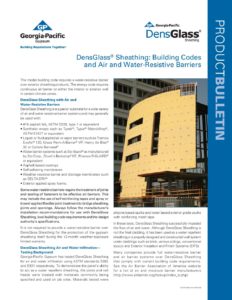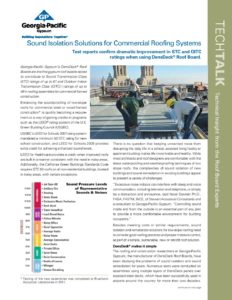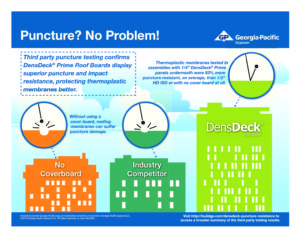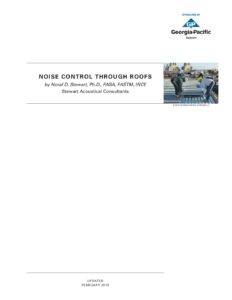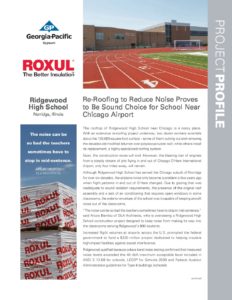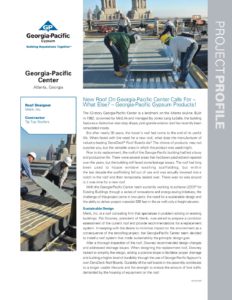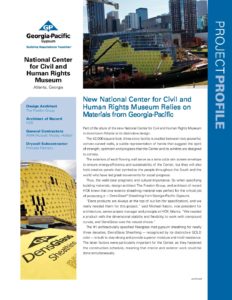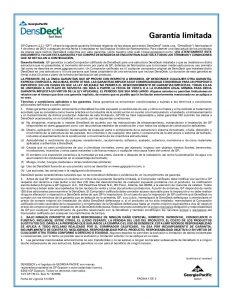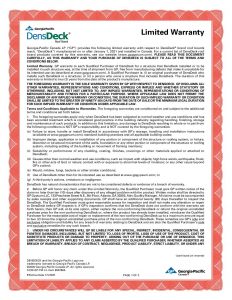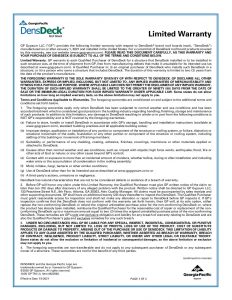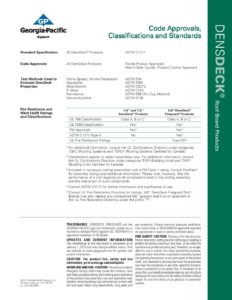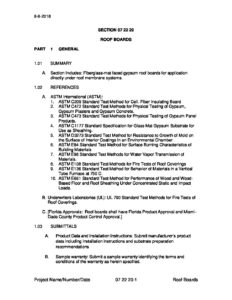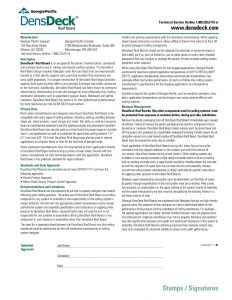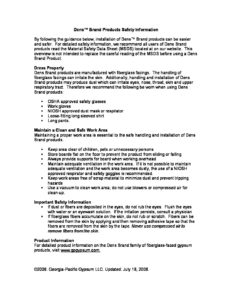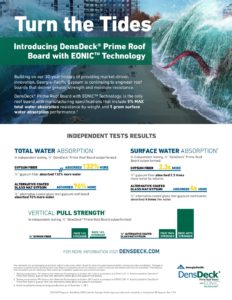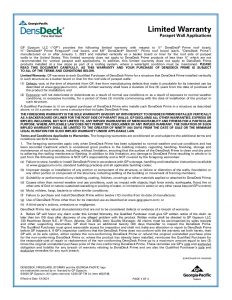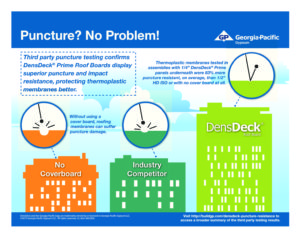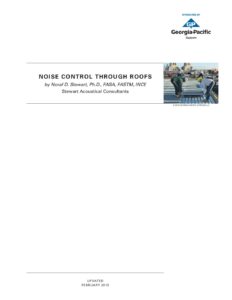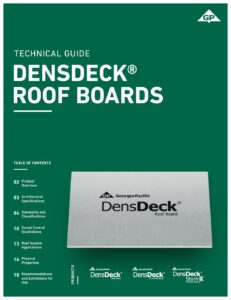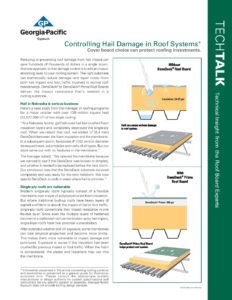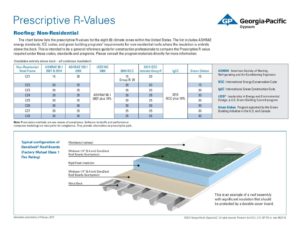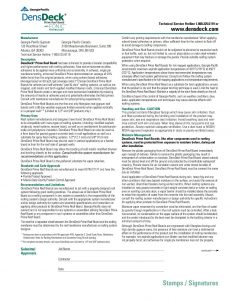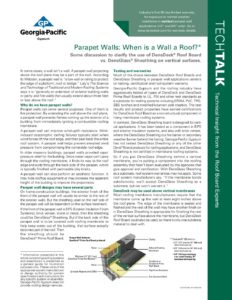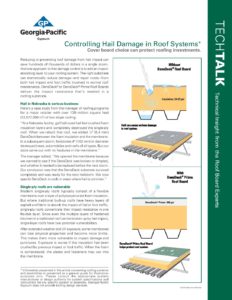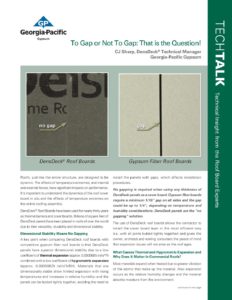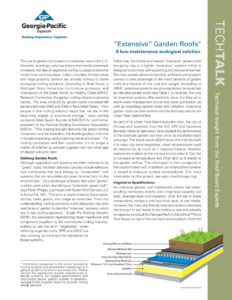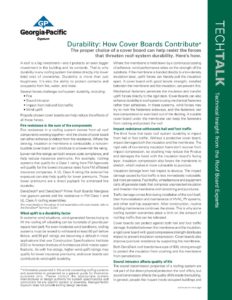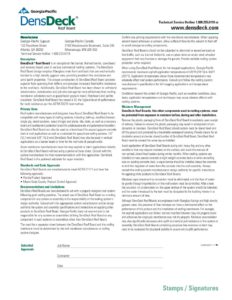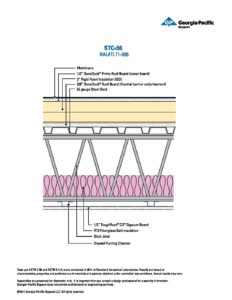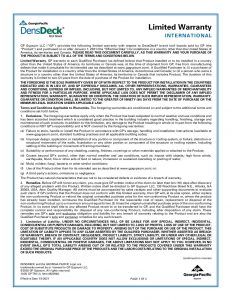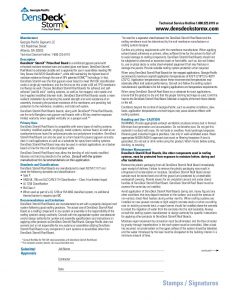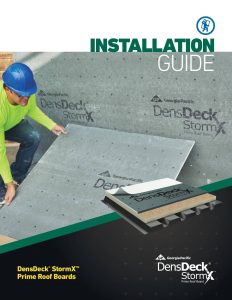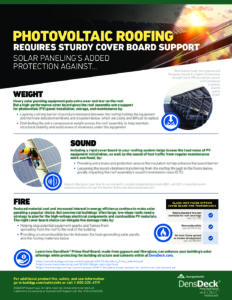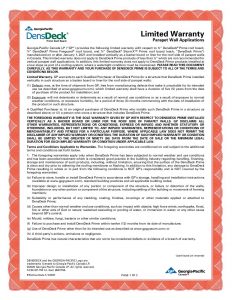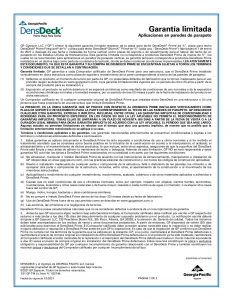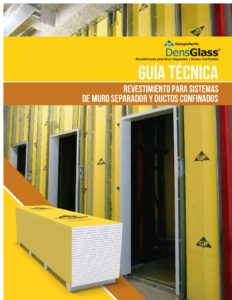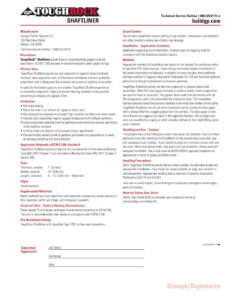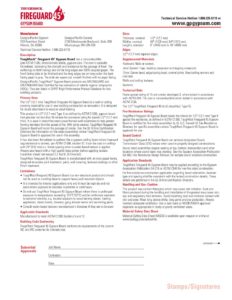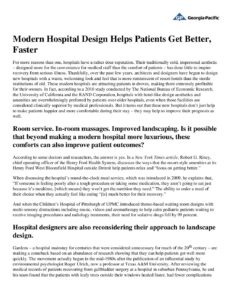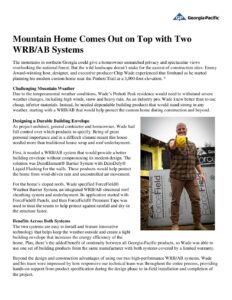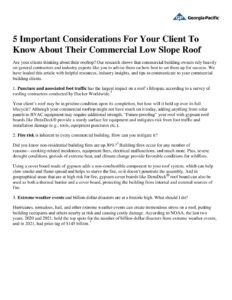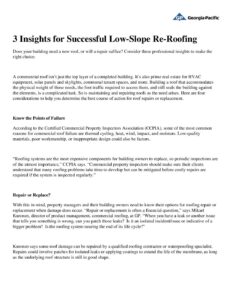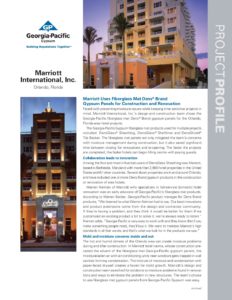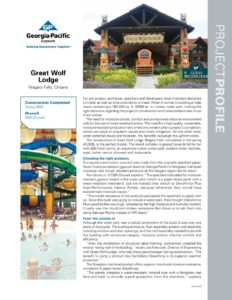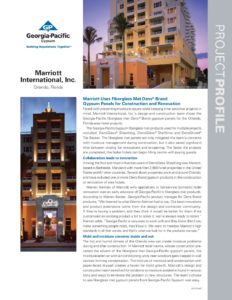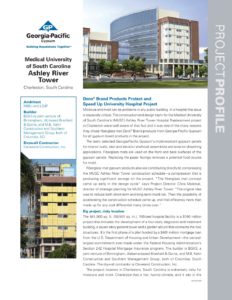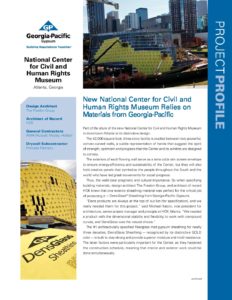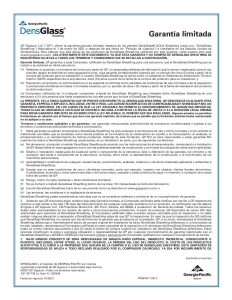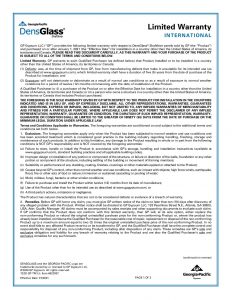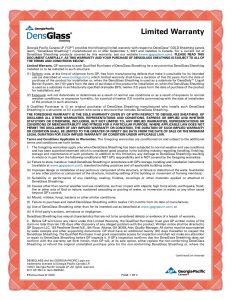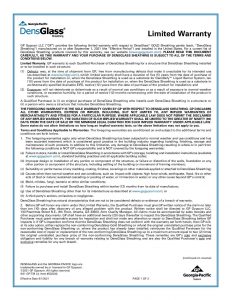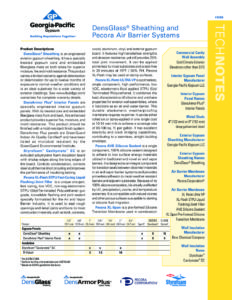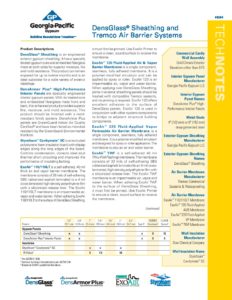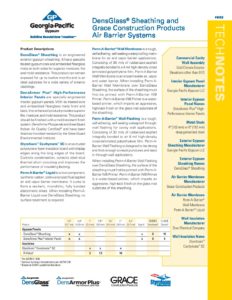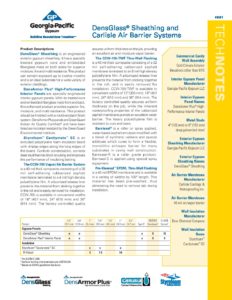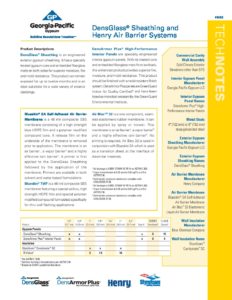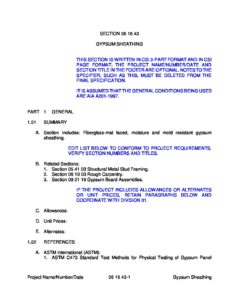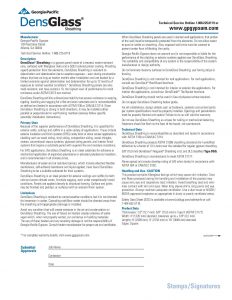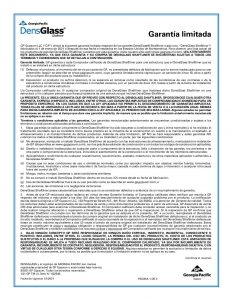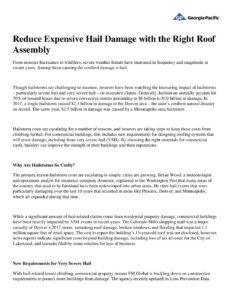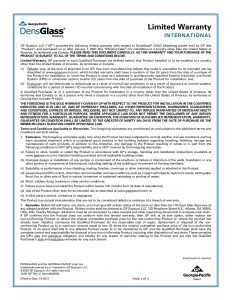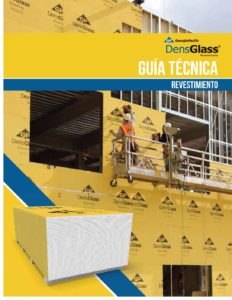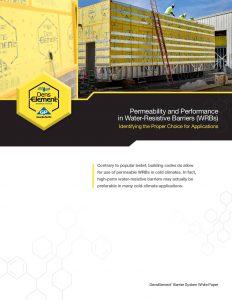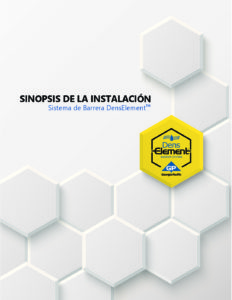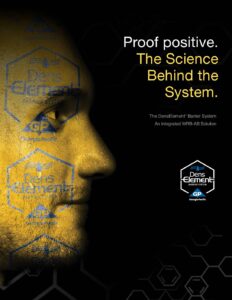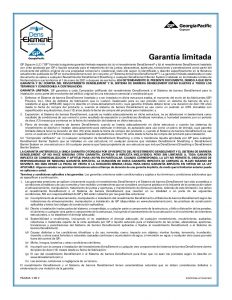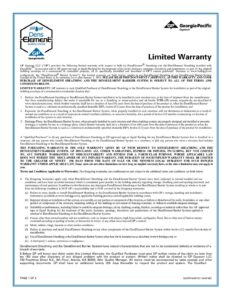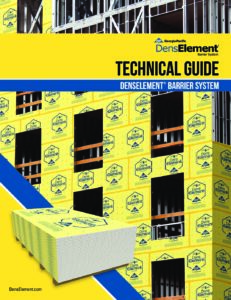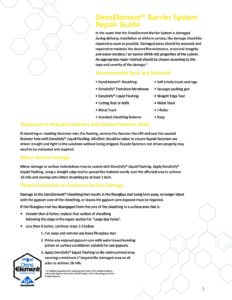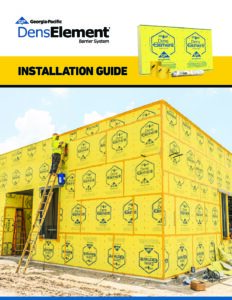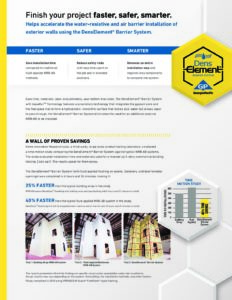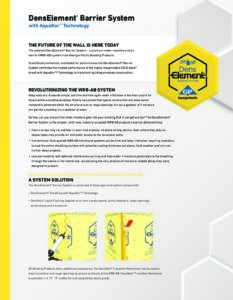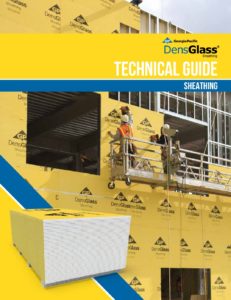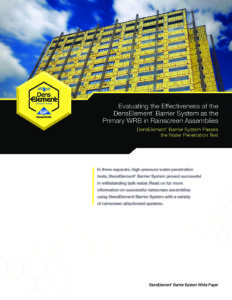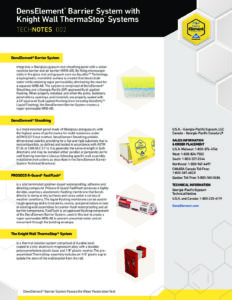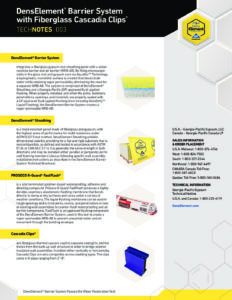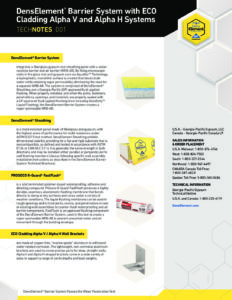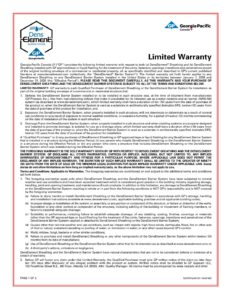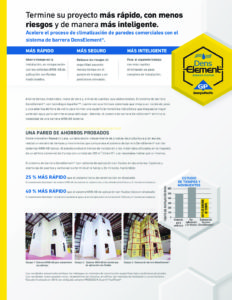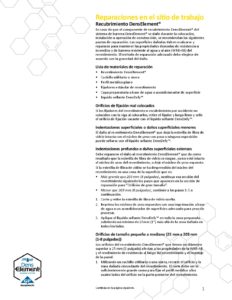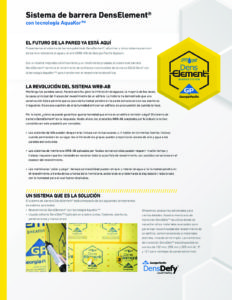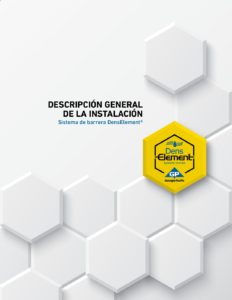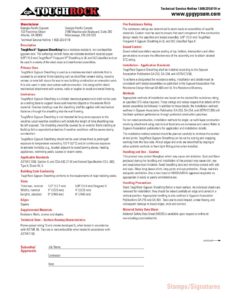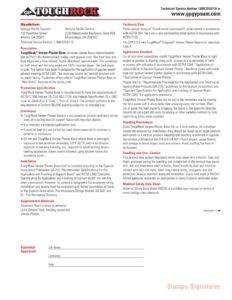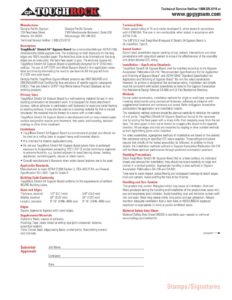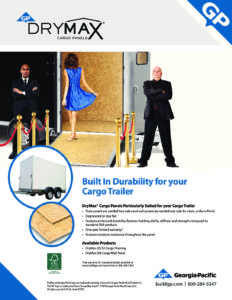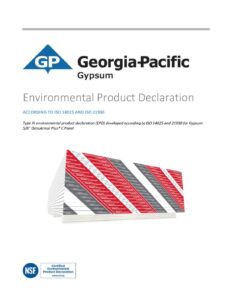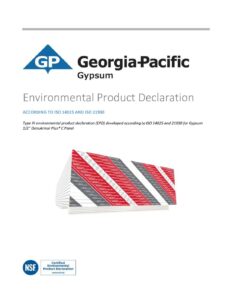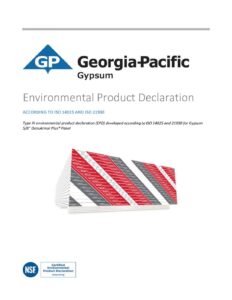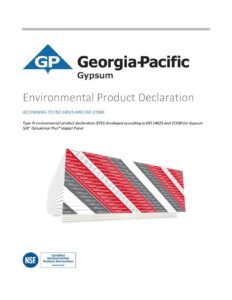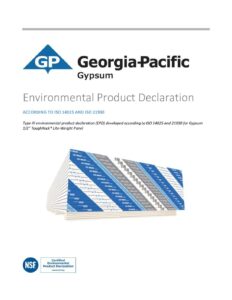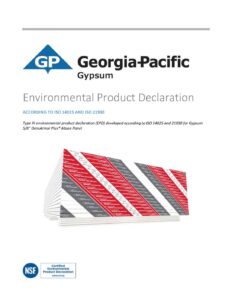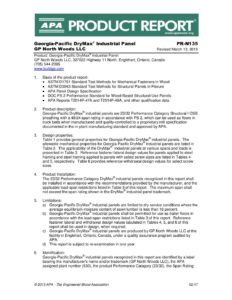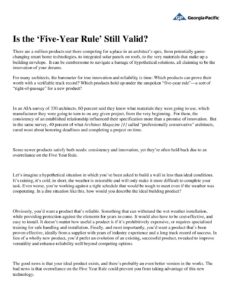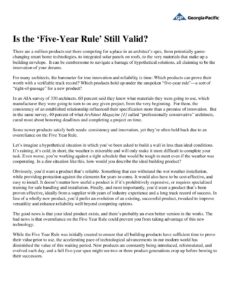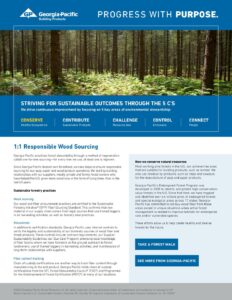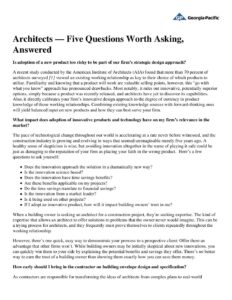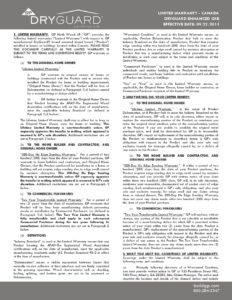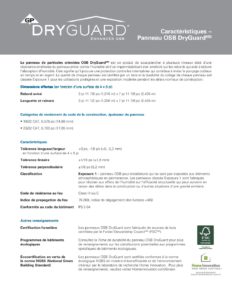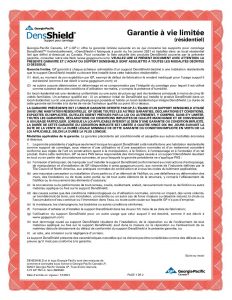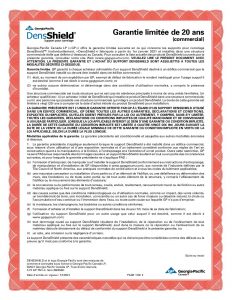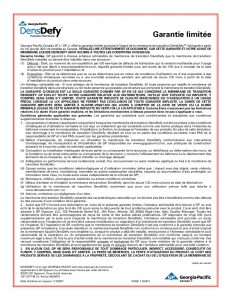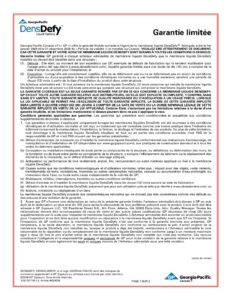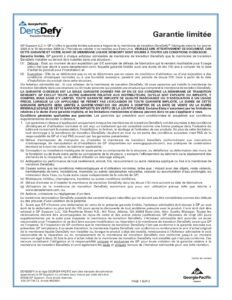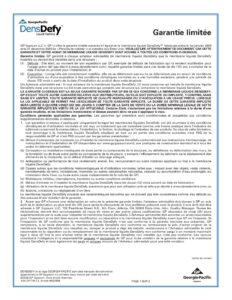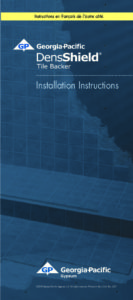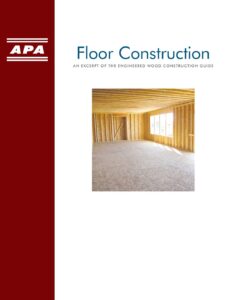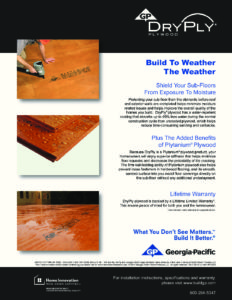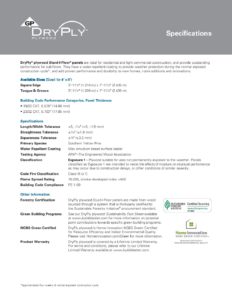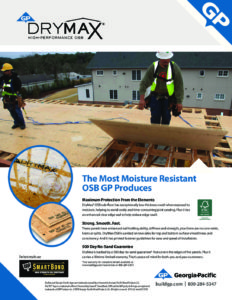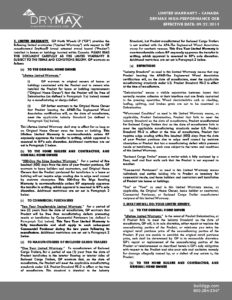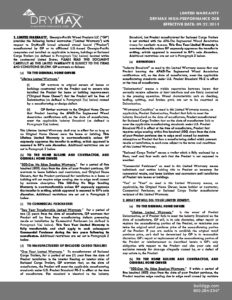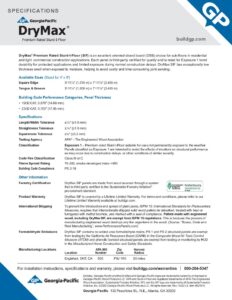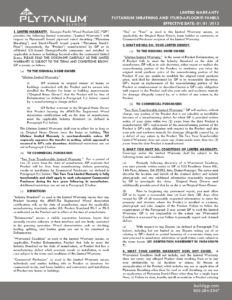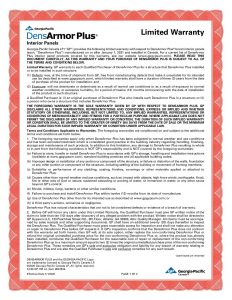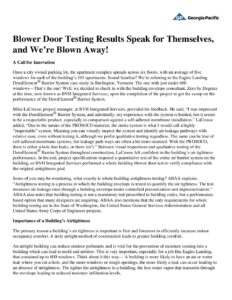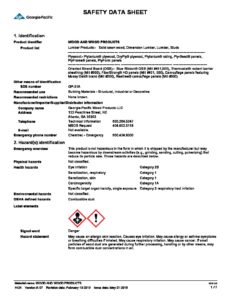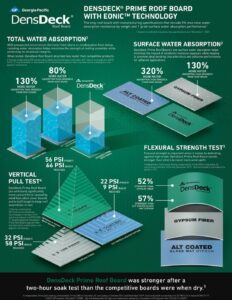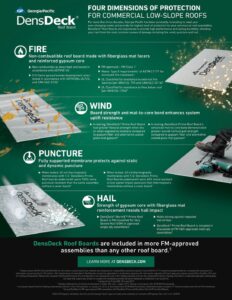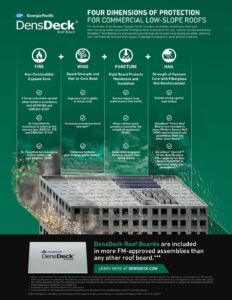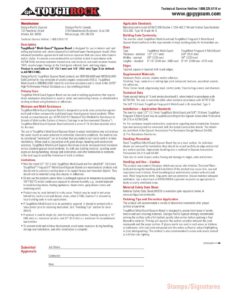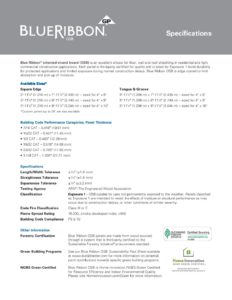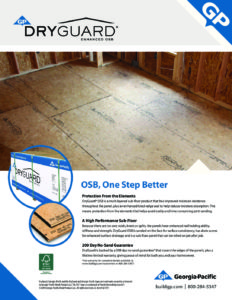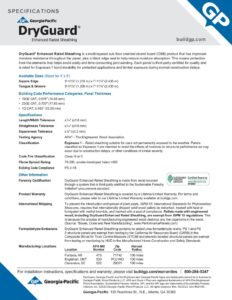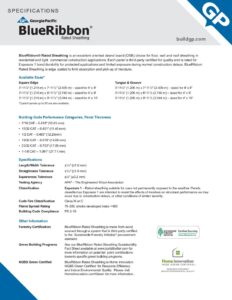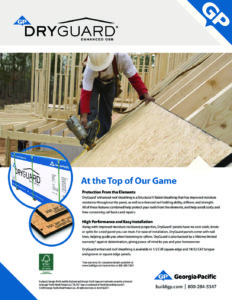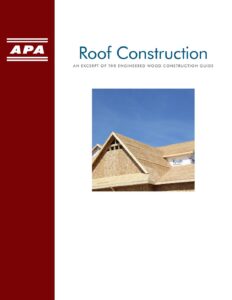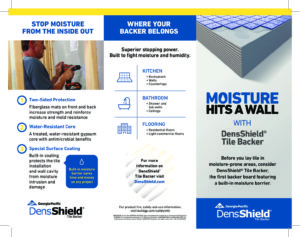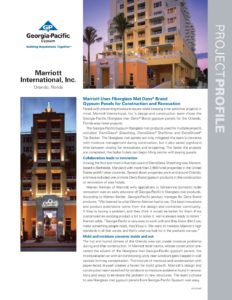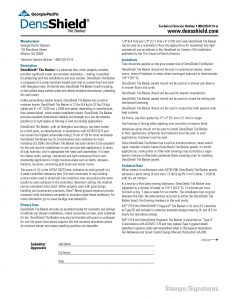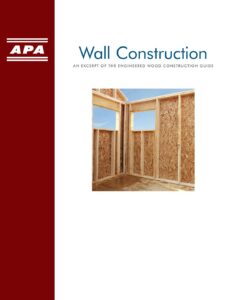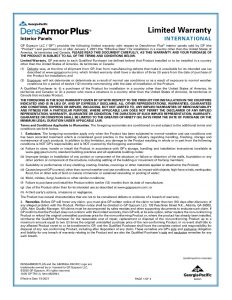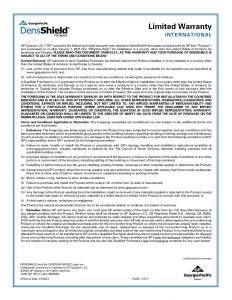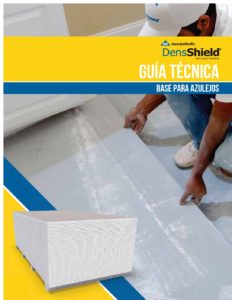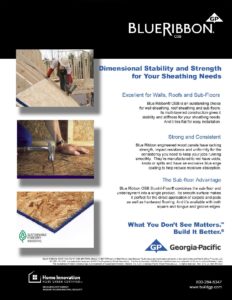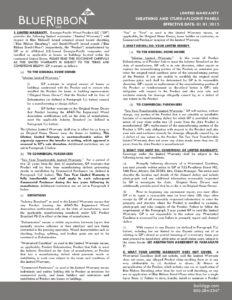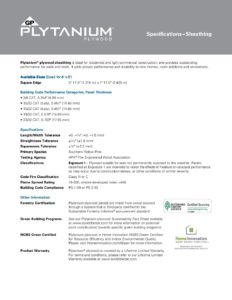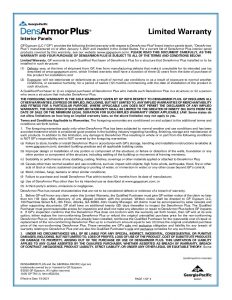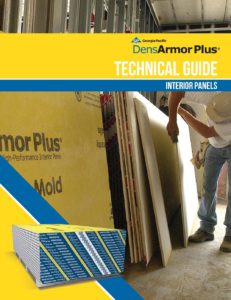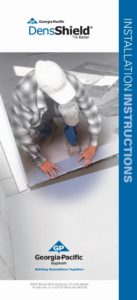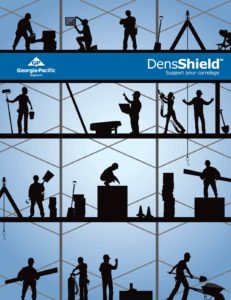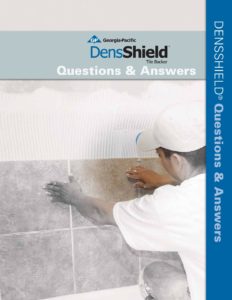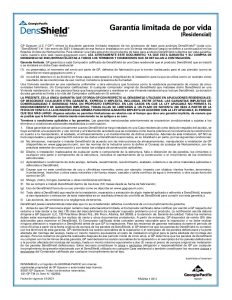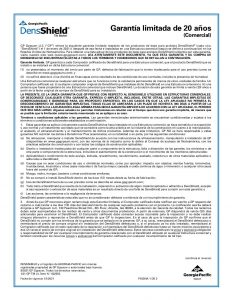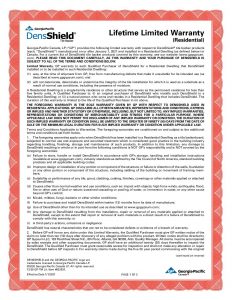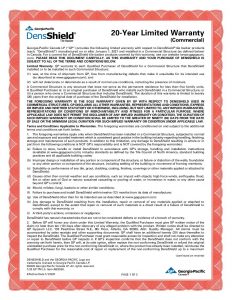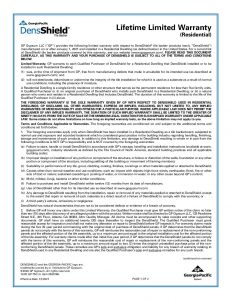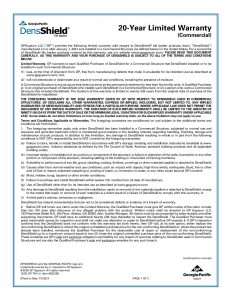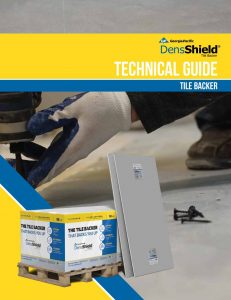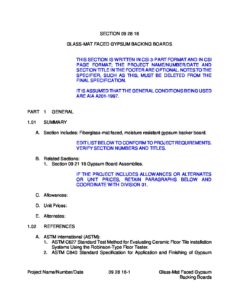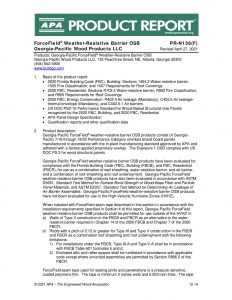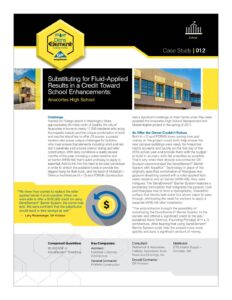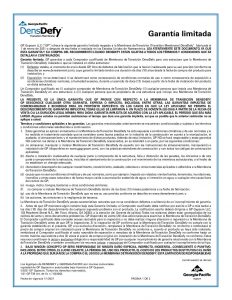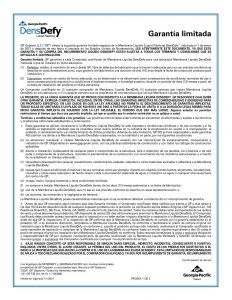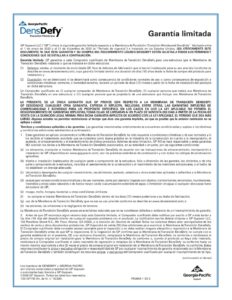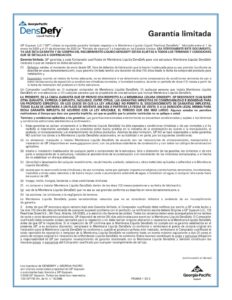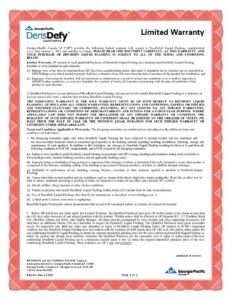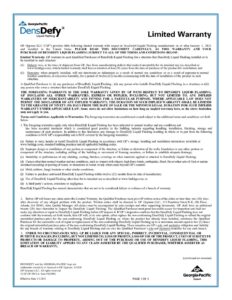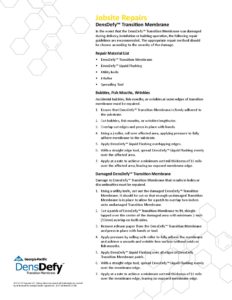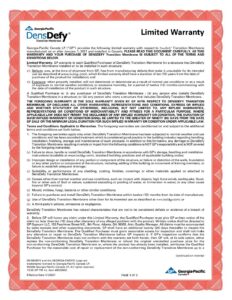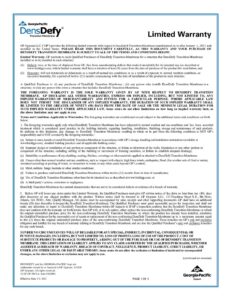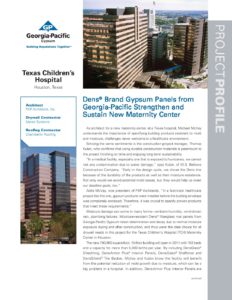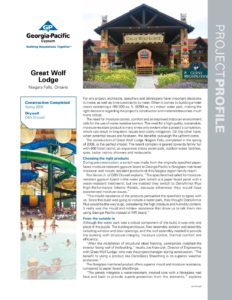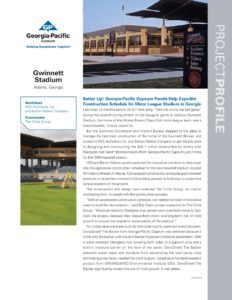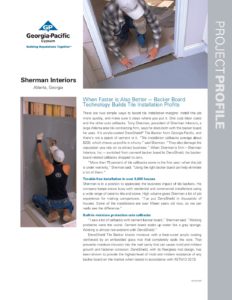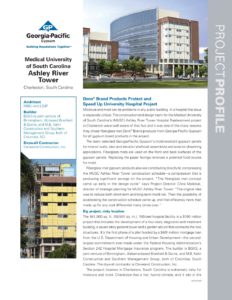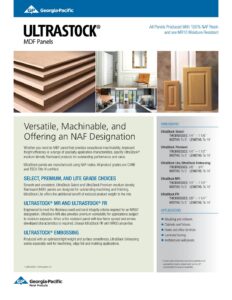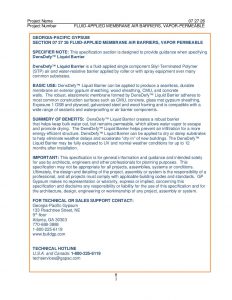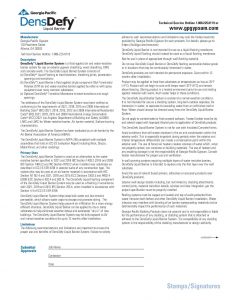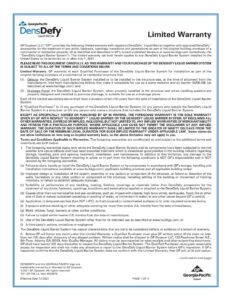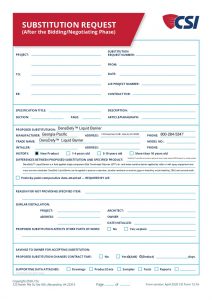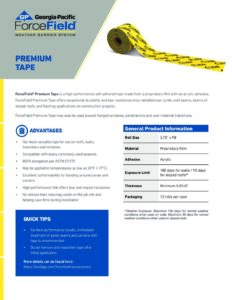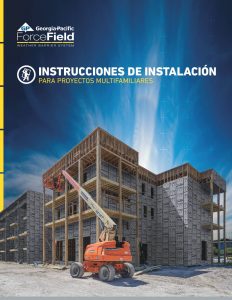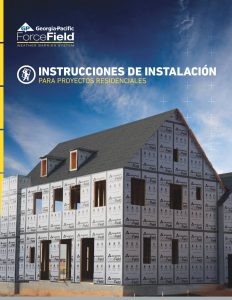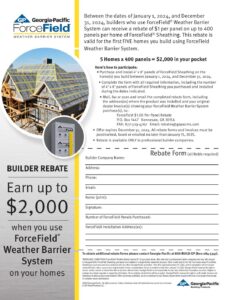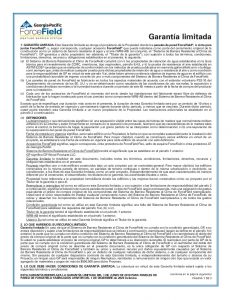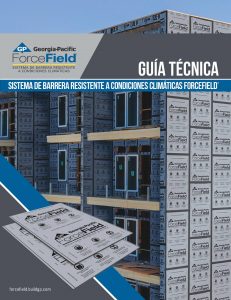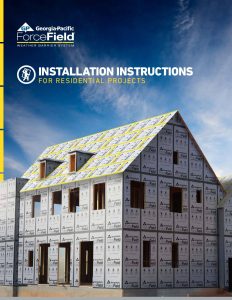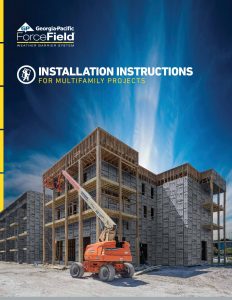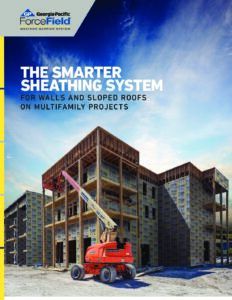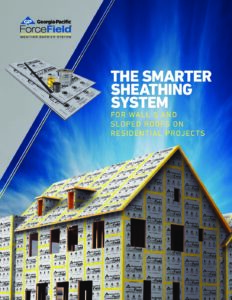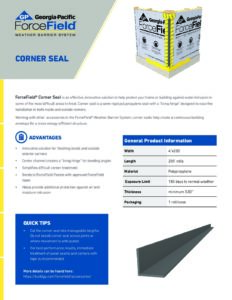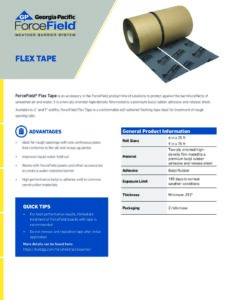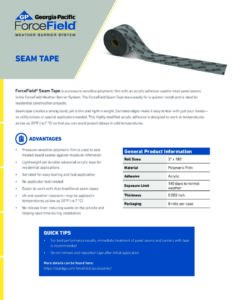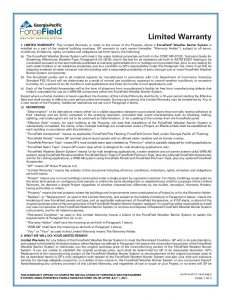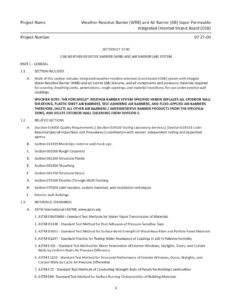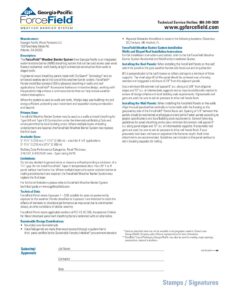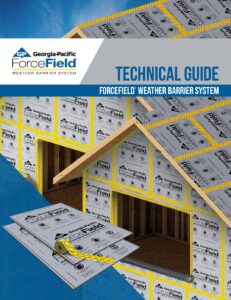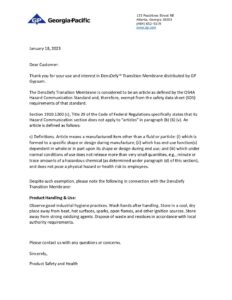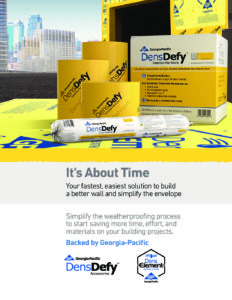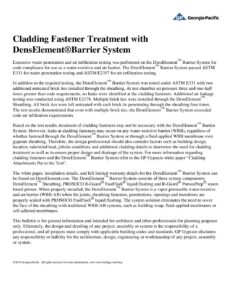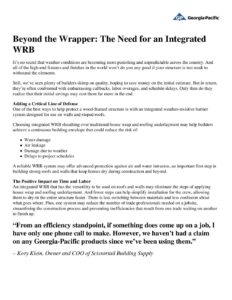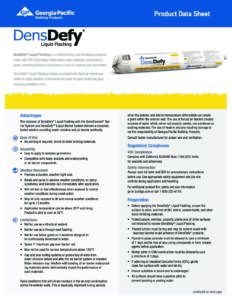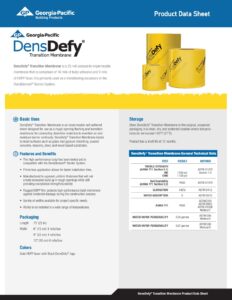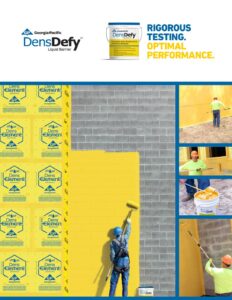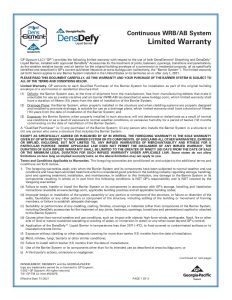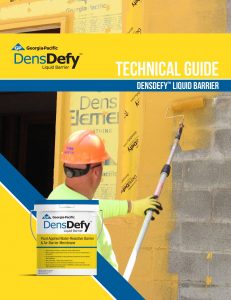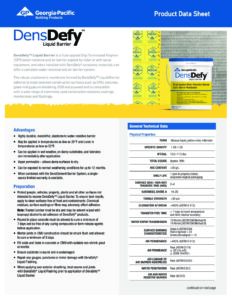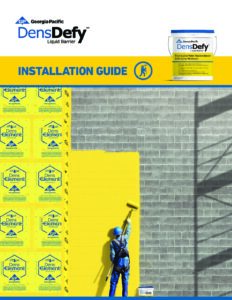No results found, try expanding your search filters.
Does 1/2" (12.7 mm) ToughRock® Fireguard 45® Gypsum Board provide improved fire resistance over 1/2" (12.7 mm) lightweight gypsum boards in applications other than those shown in specific UL designs?
Yes. In third party testing, 1/2″ (12.7 mm) ToughRock Fireguard 45 Gypsum Board lasted longer than 1/2″ (12.7 mm) lightweight gypsum board when tested in similar assemblies. For additional information concerning fire ratings and fire safety, go to www.buildgp.com/safetyinfo.
Is ToughRock Shaftliner® mold resistant?
ToughRock Shaftliner incorporates moisture-resistant paper but is not tested specifically for mold resistance. If you require a shaftliner product that has been tested for mold resistance in accordance with ASTM D3273, consider using DensGlass® Shaftliner. Please note that ToughRock® Shaftliner is not designed for exposure to constant high-moisture conditions or direct water.”
Is ToughRock® Sheathing mold resistant?
ToughRock Sheathing incorporates a moisture-resistant core and paper but is not tested specifically for mold resistance. If you require a sheathing product that has been tested in accordance with ASTM D3273, consider using DensGlass® Sheathing or DensElement® Sheathing.
What is the fire rating of ToughRock® Fireguard C® Soffit Board?
There is not a fire rating on an individual board. The fire rating is based on an entire assembly (studs, board, fasteners, etc.) being tested together. Please consult the Gypsum Association GA-600 Fire Design Manual or UL Fire Resistance Directory for specifics on a particular fire-rated assembly. For additional information concerning fire ratings and fire safety, go to www.buildgp.com/safetyinfo.
What is the fire rating of ToughRock® Fireguard C® Gypsum Board?
There is not a fire rating on an individual board. The fire rating is based on an entire assembly (studs, board, fasteners, etc.) being tested together. Please consult the Gypsum Association GA-600 Fire Design Manual or UL Fire Resistance Directory for specifics on a particular fire-rated assembly. For additional information concerning fire ratings and fire safety, go to www.buildgp.com/safetyinfo.
What is the fire rating of ToughRock® Fireguard X® Gypsum Board?
There is not a fire rating on an individual board. The fire rating is based on an entire assembly (studs, board, fasteners, etc.) being tested together. Please consult the Gypsum Association GA-600 Fire Design Manual or UL Fire Resistance Directory for specifics on a particular fire-rated assembly. For additional information concerning fire ratings and fire safety, go to www.buildgp.com/safetyinfo.
Does 1/2" (12.7 mm) ToughRock® Fireguard 45® Gypsum Board have a fire rating when used on ceilings?
At this time, Georgia-Pacific Gypsum does not have any fire testing or fire rated assemblies with 1/2″ (12.7 mm) ToughRock Fireguard 45 Gypsum Board on ceilings.
Can 1/2" (12.7 mm) ToughRock® Fireguard 45® Gypsum Board take the place of 5/8" Type X gypsum boards in a fire-rated assembly?
If the assembly requires the use of 5/8″ (16.9 mm) Type X gypsum boards then 1/2″ ToughRock Fireguard 45 Gypsum Board may not be used in place of 5/8″ Type X gypsum boards to maintain the stated fire rating.
Can 1/2" (12.7 mm) ToughRock® Fireguard 45® Gypsum Board be used in area separation walls?
1/2″ (12.7 mm) ToughRock Fireguard 45 Gypsum Board may be used in place of any unclassified 1/2″ (12.7 mm) gypsum board.
Can 1/2" (12.7 mm) ToughRock® Fireguard 45 Gypsum Board be used on ceilings?
1/2″ (12.7 mm) ToughRock Fireguard 45 Gypsum Board is manufactured to meet ASTM C1396 sections 5 and 12. When installed parallel or perpendicular to the joists, it is able to span ceilings joists spaced up to 24″ (610 mm) o.c. Please consult the local building code to confirm specific requirements.
Where can 1/2" (12.7 mm) ToughRock® Fireguard 45® Gypsum Board be used?
This product may be used anywhere where regular or lightweight gypsum boards are used today. If a mold-resistant product is required, we would recommend 1/2″ (12.7 mm) ToughRock® Mold-Guard™ Gypsum Board.
Should the ToughRock Fireguard C gypsum board be installed vertically or horizontally?
While gypsum boards are stronger in one direction, for walls, they may be installed either vertically or horizontally on both wood and steel studs. If the boards are to be used in a fire rated assembly, then use the board orientation that is stated in your specific rated assembly.
Since 1/2" (12.7 mm) ToughRock® Fireguard 45® Gypsum Board is considered Type X, is it listed in any UL designs?
1/2″ (12.7 mm) ToughRock Fireguard 45 Gypsum Board is currently listed in UL designs V315 and V316.
What is the fire rating of ToughRock® Lite-Weight Fire-Rated Gypsum Board?
There is not a fire rating on an individual board. The fire rating is based on an entire assembly (studs, board, fasteners, etc.) being tested together. Please consult the Gypsum Association GA-600 Fire Design Manual or UL Fire Resistance Directory for specifics on a particular fire rated assembly. For additional information concerning fire ratings and fire safety, go to www.buildgp.com/safetyinfo.
Do I need to space the panels in my trailers?
Yes, all wood structural panels have the potential to elongate with increase in moisture content (called linear expansion), increasing the risk of edge ridging or buckling. Spacing panels helps minimize this risk.
Do DryMax cargo panels have a warranty?
Yes, the panels have a one-year limited warranty for enclosed trailer applications.
Can DensArmor Plus® panels be used in an exterior soffit?
Yes, DensArmor Plus® panels are suitable for soffit applications where it is not exposed directly to the elements. It can be finished using a setting-type joint compound prior to priming and painting.
Can DensArmor Plus® panels be used as an exterior sheathing?
No. DensArmor Plus® panels should not be used on exterior applications. See DensGlass® Sheathing.
Do your panels meet formaldehyde emissions standards?
Yes, Georgia-Pacific plywood and OSB panels only use moisture resistant adhesives that contain no added urea formaldehyde resins, and are therefore exempt from U.S. EPA and California formaldehyde regulations due to their very low emission rates.
What is the STC for 1/2" (12.7 mm) ToughRock® Fireguard 45® Gypsum Boards in wall assemblies when compared to 1/2" (12.7 mm) light weight gypsum boards on the market today?
Since 1/2″ (12.7 mm) ToughRock Fireguard 45 Gypsum Board is a heavier product, the sound resistance of the wall or ceiling may be better if it is used in place of 1/2″ light weight gypsum boards. Many factors affect the sound resistance of your wall including the spacing of your studs, the type of studs, the use of insulation or resilient channel, the spacing of fasteners, etc. In independent lab testing, 1/2″ (12.7 mm) ToughRock Fireguard 45 Gypsum Board wall assemblies performed 1 – 4 STC better than comparable assemblies constructed using 1/2″ lightweight gypsum boards.
What is the difference between Structural 1 and Exposure 1 panels?
Structural I refers to certain specialized strength and stiffness characteristics of wood structural panels while the term Exposure 1 refers to the glue bond durability of a wood structural panel. Structural I, also referred to as “STRUC I”, may be OSB or plywood and is, essentially, a subcategory of APA Rated Sheathing. Panels designated Structural I must meet all of the manufacturing and performance standards of Rated Sheathing, as well as certain additional requirements.
The advantages of Structural I Rated Sheathing over standard Rated Sheathing panels of the same Performance Category are realized in certain specialized engineered applications such as engineered shear walls and engineered horizontal diaphragms. Specialized construction situations requiring installation of roof sheathing panels with the strength axis parallel to supporting structure also benefit from the use of Structural I sheathing. Structural I is of no additional benefit for other traditional construction applications. Consult a professional engineer for specific applications.
What is the difference between Exterior and Exposure 1 panels?
Exterior panels are suitable for applications subject to long-term exposure to weather or moisture, while panels classified as Exposure 1 are intended to resist the effects of moisture on structural performance as may occur due to construction delays, or other conditions of similar severity. Exposure 1 panels are made with the same exterior adhesives used in Exterior panels. However, because other compositional factors may affect bond performance, only Exterior panels should be used for long-term exposure to weather.
Which side of DensArmor Plus® Interior Panels should be painted or finished?
Attach the DensArmor Plus® panel with the GOLD color side of the panel facing the studs or furring strips. Paint or apply a finish to the white, tapered edge side of the panel facing the interior of the room.
Is there a mold warranty for DensArmor Plus® high-performance interior panels?
There is no mold warranty. However, DensArmor Plus® interior panels carry a limited warranty against delamination and deterioration for up to 12 months of exposure to normal weather conditions when used on walls (PDF: 496KB/1pg).
How does one finish DensArmor Plus® high-performance interior panels?
There are several suitable finishes over DensArmor Plus® panels including tile, wallpaper, texturing, or paint. To determine how to prep the panel for the final finish download the DensArmor Plus Technical Guide.
What wood species are used in making DryMax cargo panels?
Out of our Englehart, Ontario, Canada mill we use northern hardwoods, primarily Aspen.
How are DryMax panels constructed that cause them to lay flat?
DryMax cargo panels have four distinct layers with a strict balance of opposing surface layers. This construction helps the panels lay flat and also helps give them their dimensional strength properties.
What makes DryMax® cargo panels different from standard OSB products?
DryMax® cargo panels are produced using a special manufacturing formulation that makes the product more moisture resistant, durable and stable than regular OSB products. These qualities make DryMax panels ideal for cargo and trailer applications that require a panel that can stand up to constant rigor and wear and tear.
Is ToughRock® Shaftliner listed in the same fire-rated assemblies as DensGlass® Shaftliner?
ToughRock Shaftliner is listed in assemblies with the UL type designation TP-6. DensGlass® Shaftliner is listed in assemblies with the UL type designation DGUSL. Please consult the specific assembly for permitted products and details. For additional information concerning fire ratings and fire safety, go to www.buildgp.com/safetyinfo.
Can I use DensShield® Tile Backer in fire-rated wall assemblies?
Yes. 5⁄8” (15.9 mm) DensShield® Fireguard® Tile Backer is manufactured to meet Type X requirements (per ASTM C1178) and can be substituted in any generic assemblies using a 5⁄8” (15.9 mm) Type X gypsum board. This permits the use of numerous 1-hour and 2-hour assemblies for both wood and metal frame construction. Transition to regular 5⁄89 (15.9 mm) Type X board is also minimized. For additional information concerning fire ratings and fire safety, go to www.buildgp.com/safetyinfo.
Are special tile setting materials needed to work with DensShield Tile Backer panels?
No. DensShield Tile Backer requires the same type of setting materials as any other backer board. No special mastics or thin-sets are required. To set tile, use a latex-Portland cement mortar, or other products recommended by the mortar manufacturer. Follow the tile setting manufacturer’s instructions for applying tile setting material. Dry-set or thin-set latex-modified mortars are most commonly used with DensShield Tile Backer and cement backers. Use only latex-modified mortars in floor applications.
Must an additional moisture barrier be supplied and installed when using DensShield Tile Backer panels?
No. The grey face (tile side) of DensShield Tile Backer has a heat cured acrylic coating which is a built-in moisture barrier and vapor retarder so that no additional moisture barrier is required. In fact, an additional moisture barrier to the back side of DensShield Tile Backer is NOT recommended. Prior to the tile installation it is permissible to apply a fluid applied membrane to the face of DensShield Tile Backer for enhanced moisture resistance.
What are the similarities and differences in DensArmor Plus® Interior Panels and DensShield® tile backer?
Both use fiberglass mats as the back facer material. When installed against the wall framing, both products provide a fiberglass mat surface facing the wall cavity that resists possible mold growth on the back of the panel. DensShield® tile backer and DensArmor Plus® panels both have cores that are moisture resistant, manufactured to ASTM C 1396, section 7 specifications.
Can DensArmor Plus® panels be used anywhere else besides the interior of the exterior wall?
Yes; any interior wall, basement wall, laundry room or ceiling that is in an area prone to high humidity are sound applications.
Can a contractor use DensArmor Plus® panels in a pool area, or a pump house and other areas of extreme moisture?
DensArmor Plus® interior panels are suitable to replace green board. It should not be specified in areas that will see moisture levels higher than that of a residential bathroom. For pool areas, see DensShield® Tile Backer.
How do DryMax cargo panels compare to plywood in terms of strength and fastener holding ability?
DryMax cargo panels are Structural-1 grade panels manufactured specifically for industrial use. They are comparable in strength and fastener holding to commercial plywood grades. Specific information about DryMax cargo panel properties can be found in APA Product Report PR-N135 at www.apawood.org.
How often is a control joint required?
Placement of control joints are determined by the design professional. When they are not designated, the requirement for ceilings and walls is the same. A control joint should be installed every 30 feet when there is not perimeter relief. When there is perimeter relief, control joints can be installed every 50 feet.
What should we do if the gypsum board gets wet?
According to the Gypsum Association publication GA-231, gypsum board should not be allowed to get wet; it should be covered if stored outside. However, there are situations where the board could get wet during transportation/storage or when installed in-place. If the board gets wet in an installed in-place situation, first remove the sources of moisture. Lay the board on a flat surface and allow it to dry out thoroughly. Once the board is dry, examine it for paper-to-core bond and mold and mildew growth. If installed, examine for nail pops and sag (in the case of ceilings). Paper-to-core bond failure and board sag are irreversible damage, and the board should be replaced. For nail pops, place a fastener an inch above or below any popped-up nail.
Should gypsum board be installed vertically or horizontally?
While gypsum boards are stronger in one direction, they may be installed either vertically or horizontally on both wood and steel studs. If the boards are to be used in a fire rated assembly, then use the board orientation that is stated in your specific rated assembly.
Does ToughRock® Shaftliner have recycled content?
The paper facers are made with 100% recycled paper. The total amount of recycled content depends on the manufacturing location.
Does ToughRock® Shaftliner carry a limited warranty for exposure to weather conditions?
Georgia-Pacific Gypsum does not offer a limited warranty for ToughRock Shaftliner for exposure to weather conditions. If you require a product that does have a limited warranty for exposure to normal weather conditions, consider using DensGlass® Shaftliner.
What is the weight of this product?
It is approximately 1.6 lbs./sq. ft (7.8 kg/m2) which is consistent with standard 1/2” (12.7 mm) ToughRock® Gypsum Board.
What do you mean when you state this product is a Type X gypsum board?
Per ASTM C1396, section 4.3.1, 1/2″ (12.7 mm) thick gypsum board shall be considered Type X when the assembly provides not less than 3/4-hour fire resistance when tested in accordance with ASTM E119. For additional information concerning fire ratings and fire safety, go to www.buildgp.com/safetyinfo.
What happened to Georgia-Pacific's regular 1/2" gypsum board?
Georgia-Pacific has always made a quality 1/2″ paper-faced gypsum board. In the first half of 2015, Georgia-Pacific Gypsum introduced an upgraded 1/2″ paper-faced gypsum board called ToughRock® Fireguard 45™ Gypsum Board. The improved 1/2” board has enhanced fire-resistive properties and can replace standard and lightweight gypsum board in ALL 1/2″ wall and ceiling assemblies, including 24″ o.c. framed ceilings. ToughRock Fireguard 45 Gypsum Board is a standard weight 1/2″ interior wallboard that has achieved a 45-minute UL classified fire rating in select assemblies (consult local codes for actual requirements). For additional information concerning fire ratings and fire safety, go to www.buildgp.com/safetyinfo.
Research used to shape the innovation process considered consumer concerns about home fire safety. Learn more>>
Are there published negative wind load values for ToughRock® Sheathing?
Yes. Use the Negative Wind Load Resistance values as listed in Gypsum Association GA 235. If specific published test values are required, we would recommend using DensGlass® Sheathing or DensElement® Sheathing, which have published negative wind load resistance.
Can ToughRock® Sheathing be used on exterior corridor protected ceilings and soffits?
Georgia-Pacific does not recommend using ToughRock Sheathing for these applications. Instead, consider using ToughRock® Fireguard C® Soffit Board , DensArmor Plus® Type C, or DensGlass® Sheathing, depending on the fire rated design and are designed for soffit applications.
Can one apply adhered membranes or fluid applied air barriers to ToughRock® Sheathing?
Air barrier membranes and coatings can be applied to ToughRock Sheathing. See the manufacturer’s recommendations for substrate and job site condition limitations.
Does ToughRock® Sheathing have recycled content?
The paper facers are made with 100% recycled paper. The total amount of recycled content depends on the manufacturing location. Refer to GP Gypsum Technical Services (1-800-225-6119) for more information.
How is ToughRock® Sheathing installed?
ToughRock Sheathing should be installed per ASTM C1280 and Gypsum Association documents GA-253 and GA-254.
Does ToughRock® Sheathing carry an exposure warranty?
Georgia-Pacific Gypsum does not offer a limited warranty for ToughRock Sheathing for exposure to weather conditions. Per the Gypsum Association publication, GA-253, the product needs to be covered with a weather-resistive barrier within 30 days of installation. If you require a product that does have a limited warranty for exposure to normal weather conditions, consider using DensGlass® Sheathing or DensElement® Sheathing.
Can I use gypsum board in ceilings at 24" o.c. support?
According to the Gypsum Association publication GA-216, gypsum board could be applied in a ceiling framed 24″ o.c. provided the board length is at right angles (perpendicular) to the framing members. When a water-based texture is to be applied, the maximum spacing for traditional 1/2″ gypsum board is 16″ o.c.
We always advise our customers to use either 5/8″ board, ToughRock® CD® ceiling board, or 1/2″ ToughRock Lite-Weight in such applications. Once the board sags, it is much more expensive to replace than to use the right product initially. Sag in the ceilings of new homes is a common complaint. Most often, research reveals it is not the board but job site conditions that cause the board to sag. Propane heaters combined with poor ventilation cause build-up of moisture in the house.
What does the stamp on my OSB panel mean?
On every Georgia-Pacific sheathing panel you should be able to find an APA grade stamp. This stamp is your assurance that the product is manufactured in accordance with the APA’s rigorous program of quality inspection and testing. The grade stamp on a panel also tells you a lot about the panel – the span rating, exposure rating, panel thickness and the building code approval the panel meets.
What does the stamp on my plywood panel mean?
On every Georgia-Pacific sheathing panel you should be able to find an APA grade stamp. This stamp is your assurance that the product is manufactured in accordance with the APA’s rigorous program of quality inspection and testing. The grade stamp on a panel also tells you a lot about the panel – the span rating, exposure rating, panel thickness and the building code approval the panel meets.
Which side is the back of the DensArmor Plus® panel?
The GOLD color side of DensArmor Plus® panels with the product logo is the back of the panel and should be installed facing the framing or studs. The white side or front has tapered edges for finishing.
DensShield® tile backer and DensArmor Plus® interior panel differences:
DensArmor Plus® interior panels do not have a water-stopping surface coating. The coating on DensShield® tile backer provides a water barrier to stop moisture from penetrating into the product and wall. DensShield tile backer is made to be used in wet areas such as showers and tub areas as a substrate for ceramic tile. DensShield tile backer is manufactured to meet ASTM C 1178. DensArmor Plus interior panels feature a tapered edge for joint finishing while DensShield tile backer has a square edge.
What does the "span rating" of an OSB panel mean?
Within the grade stamp on a panel you will find the span rating. When there are two numbers separated by a slash (i.e. 48/24), the first number is the maximum recommended center-to-center spacing for supports in inches when the panel is used for roof sheathing with the long dimension across supports. The second number is the maximum center-to-center spacing of supports in inches when the panel is used for sub-flooring with the long dimension across supports.
What does the "span rating" of a plywood panel mean?
Within the grade stamp on a panel you will find the span rating. When there are two numbers separated by a slash (i.e. 48/24), the first number is the maximum recommended center-to-center spacing for supports in inches when the panel is used for roof sheathing with the long dimension across supports. The second number is the maximum center-to-center spacing of supports in inches when the panel is used for sub-flooring with the long dimension across supports.
Does GP's wood come from sustainably managed forests?
Plywood panels from Georgia-Pacific are made from wood sourced through a system that is third-party certified to the Sustainable Forestry Initiative® procurement standard.
What is MDI resin?
MDI is an adhesive binding agent used to help give DryMax cargo panels and other enhanced GP engineered wood products their added moisture resistance, durability and stability.
What is a “no sand guarantee”?
During construction, sometimes wood panels exposed to high amounts of rain or other forms of moisture can swell. If the panels swell too much, particularly on the edges, sanding might be required to level the surface before the application of the finish flooring. With DryMax, GP guarantees no sanding will be required for up to 500 days.
What is Sturd-I-Floor®?
Sturd-I-Floor® is an APA designation that is a combination subfloor-underlayment produced from OSB or plywood. These panels feature a built-in underlayment that allows the convenience of using only Sturd-I-Floor® under certain finish flooring, especially carpet and pad.
What is the proper way to store plywood on the yard or on a job site?
Whenever possible, store panels under a roof. Keep sanded panels and appearance-grade products away from high-traffic areas to prevent damage to surfaces. Use pieces of lumber to weigh down the top panel in a stack to reduce warpage from humidity. If moisture absorption is expected, cut steel bands on bundles to prevent edge damage.
If panels must be stored outside, stack them on a level platform supported by at least three 4x4s to keep them off the ground. Place one 4×4 in the center and the other two 4x4s 12 to 16 inches from the ends. Never leave panels or the platform in direct contact with the ground.
Cover the stack loosely with plastic sheets or tarps. Anchor the covering at the top of the stack, but keep it open and away from the sides and bottom to ensure good ventilation. Tight coverings prevent air circulation and when exposed to sunlight, may promote mold or mildew. (Source: APA Builder Tip U450: Storage and Handling of APA Trademarked Panels)
Can you paint plywood?
Yes, plywood can be painted using one coat of acrylic latex primer and at least two coats of acrylic latex paint. Oil-based paints are not recommended.
What is the flame spread classification for plywood?
Is there a difference between span ratings for OSB and plywood?
No, span ratings for similar thicknesses are the same.
How many veneers/plies make up your plywood products?
The number of veneers/plies in our plywood products depends on thickness of the product. Here are the standard number of veneers/plies for some of our common thicknesses:
¼ – 3-ply
3/8 – 3-ply
11/32 – 3-ply
15/32 – 3-ply OR 4-ply
19/32 – 4-ply OR 5-ply
23/32 – 5-ply
7/8 – 6-ply
When used in the manufacture of crates and pallets, are Georgia-Pacific plywood and OSB safe for international shipping?
To prevent the introduction and spread of plant pests, ISPM 15: International Standards for Phytosanitary Measures, requires that internationally shipped solid wood pallets be debarked, treated with heat or fumigated with methyl bromide, and marked with a seal of compliance. Pallets made with engineered wood are exempt from ISPM 15 regulations. This is because the process of manufacturing engineered wood destroys any live organisms in the wood. (Source: “Boxes, Crate and Reel Manufacturing,” www.PerformancePanels.com)
How many sheets are in a unit of plywood?
The number of panels in a unit of plywood varies depending on the type and thickness of product. On sheathing products, the piece count is typically stenciled on the side of the unit. Other products have corrugated side protectors that should indicate piece count. If you need a piece count and neither of those are visible please contact GP at 800-284-5347.
Can plywood be used for outdoor projects?
Plywood panels classified as “Exterior” are suitable for applications subject to long-term exposure to weather or moisture.
Can ToughRock Mold-Guard Gypsum Board be used in pre-rock conditions?
While ToughRock Mold-Guard has enhanced moisture and mold resistance compared to traditional paper-faced gypsum board, it is not recommended or warranted for exposure to the elements. We would recommend DensArmor Plus® Interior Panels for pre-rock conditions.
Can ToughRock® Mold-Guard™ Gypsum Board be used in wet areas?
ToughRock® Mold-Guard™ is manufactured to meet ASTM C 1396 section 7 for moisture resistant gypsum board. If your local code allows for the use of ASTM C 1396 section 7 in wet areas, then ToughRock Mold-Guard may be used in this application.
Where can I get more information on radiant barriers?
Energy Efficiency and Renewable Energy Network (EREN) – www.eren.doe.gov
Oak Ridge National Laboratory – www.ornl.gov
Reflective Insulation Manufacturers Association – www.rimainternational.org
Florida Solar Energy Center – www.fsec.ucf.edu
Where else can I use radiant barrier sheathing?
You may also find that radiant barriers can expand the use of space in your home. For instance, un-insulated, unconditioned spaces such as garages, porches, and workrooms can be more comfortable with radiant barriers. Because radiant barriers help keep attics cooler, the space is more usable for storage. You can also use radiant barrier sheathing on exterior, south-facing walls that have uninterrupted sun exposure. In a wall application, the foil side of the radiant
barrier sheathing must be installed with the foil facing the outside. The foil must also have minimum 3/4″ airspace in front of it to be effective. This can be accomplished by using furring strips on the outside of the sheathing to create the 3/4″ airspace between the sheathing’s foil face and the siding, brick or other material used on the exterior of the wall. Be sure to check with your local building codes for compliance in the installation of any siding product. You may also want to check with your siding manufacturer for the use of their siding in conjunction with radiant barrier sheathing.
Can I use Thermostat radiant barrier sheathing on vaulted ceilings or metal roofs?
Yes, Thermostat radiant barrier sheathing can be used in both types of construction as long as you maintain a minimum 3/4″ airspace for the foil surface. In both cases, the foil face should be installed facing down.
How much can I save by using Thermostat radiant barrier sheathing?
Energy usage varies according to many factors, including individual preferences and the fluctuation of energy costs in general. The amount of energy consumed is directly related to:
- The house cooling system, which includes insulation levels, roof color, thermostat settings, tightness of the building envelope, climate conditions, design and location of the house, size of house, efficiency of cooling equipment and other factors.
- The percentage contribution of heat transfer through the ceiling to the home’s cooling load. Cooling load is the amount of heat the air conditioner has to remove to sustain an adequate temperature in the living areas. Tests done by the Department of Energy show that ceiling heat gains represent about 12 to 25 percent of a home’s total cooling load.
- Since everyone’s home and lifestyle are different, and energy costs differ from area to area, we can’t calculate your exact savings from using Thermostat radiant barrier sheathing on the roof. However, it is reasonable to expect that Thermostat radiant barrier sheathing can save you somewhere between 8 – 17% of your annual cooling energy consumption in the Southeast.
Radiant barriers work in the summer months, what about the rest of the year?
In summer, when your roof gets very hot, a radiant barrier cuts air-conditioning costs by blocking a sizable portion of the downward heat gain into the building. In the warm spring and fall, radiant barriers can help save on energy and cooling by increasing your personal comfort. During these milder seasons, outdoor air temperatures are comfortable much of the time. Yet solar energy still heats up your roof, insulation, attic air, and ceiling to temperatures that can make you uncomfortably warm. An attic radiant barrier stops almost all of this downward heat transfer so that you can stay comfortable without running your air conditioning during mild weather.
What are the biggest benefits of using Thermostat radiant barrier sheathing in attics?
- Attic temperatures can be lowered by up to 30°F in the peak summer cooling season.
- Up to 17% decrease in energy consumption since the cooling system can work more efficiently due to lower attic temperatures.
- Increase in operational efficiency of cooling equipment because cooler attic temperatures allow attic mounted air conditioning systems and ductwork to operate more efficiently.
- Increased utilization of home spaces including garages, attics, porches and other spaces that do not have climate control but stay cooler and more comfortable thanks to Thermostat radiant barrier sheathing.
Can Thermostat radiant barrier sheathing damage my shingles?
The Reflective Insulation Manufacturers Association (RIMA) has published Technical Bulletin #103, which reports that in peak summer conditions, the temperature of asphalt shingles is increased only an average of 2 to 5° F over radiant barrier roof sheathing. This is not a significant temperature rise and most shingle manufacturers have indicated that it does not affect their shingle warranties. However, you may wish to review your warranty to be sure it will not be voided. Contact your shingle manufacturer directly with any questions and ask for any changes in coverage to be provided in writing.
If I use Thermostat radiant barrier sheathing, do I still need insulation?
Yes. Thermostat radiant barrier sheathing is designed to work with, not in lieu of, standard attic insulation. Conventional insulations such as fiberglass, cellulose, foam and others do not insulate against radiant heat transfers.
How do I install Thermostat radiant barrier sheathing?
Apply Thermostat radiant barrier sheathing with the reflective (foil) side down towards the attic, directly to the roof framing. For radiant barrier sheathing to be effective long-term, the reflective side must have a minimum 3/4″ air space in front of the foil face to properly reflect radiant heat. This applies to both attic areas and cathedral type ceilings.
How do radiant barriers “block” heat?
Heat travels from a warm area to a cool area by a combination of conduction, convection, and radiation. In conduction, heat flows from a hotter material to a colder material when the two materials touch. Heat transfer by convection occurs when a liquid or gas is heated, becomes less dense, and rises.
Radiant heat travels in a straight line away from the hot surface and heats anything solid as the wave of energy hits it. The reflective material used in Thermostat radiant barrier sheathing stops up to 97% of the radiant heat from passing through to get into your attic.
Additionally, the reflective surface emits very little heat itself, so it does not transfer the heat that it blocks via radiation. In other words, it is a good heat reflector and a poor heat radiator.
What is a radiant barrier?
A radiant barrier is a layer of reflecting aluminum placed in an airspace to block radiant heat transfer between a heat-radiating surface (such as a hot roof) and a heat-absorbing surface (such as conventional attic insulation and your ceilings).
What is a DryGuard® "no sand guarantee"?
During construction, sometimes wood panels exposed to high amounts of rain or other forms of moisture can swell. If the panels swell too much, particularly on the edges, sanding might be required to level the surface before the application of the finish flooring. With DryGuard®, GP warrants that no sanding will be required for up to 200 days.
DensShield Tile Backer seems softer than cement boards. Does it have the same floor ratings?
DensShield Tile Backer is rated for residential and light commercial floors. 1⁄4” (6.4 mm) DensShield Tile Backer panels have a compressive strength of approximately 1200-1500 lbs psi, and 1⁄2” (12.7 mm) DensShield Tile Backer has a compressive strength of between 450 and 600 lbs psi. That means that it would typically take a load of 450 to 600 lbs psi to start to crush 1⁄2” (12.7 mm) DensShield Tile Backer. When a load is applied to the floor tile, the tile distributes the load over its entire area.
Can DensShield® Tile Backer be used in floor applications?
Yes. Both 1 ⁄4” (6.4 mm) and 1 ⁄2” (12.7 mm) DensShield® Tile Backer can be used in floor applications. Both of these thicknesses passed the Robinson Floor Test, the industry standard floor test for residential and light commercial ratings. The Robinson Floor Test (ASTM C627) is designed to determine how a tile assembly holds up under extreme wear and weight conditions. DensShield Tile Backer achieves the same light commercial rating as cement and fiber cement backers.
Should the fasteners be countersunk?
No. Fasteners should be flush with the coated surface and are not to be countersunk.
How is DensShield Tile Backer fastened in place?
No special or unique fasteners are required to fasten DensShield Tile Backer panels in place. For wood studs: galvanized roofing nails, rust-resistant drywall screws or bugle head deck screws. Fasteners should be long enough to penetrate at least 3⁄4 (19 mm) into the wood framing members. For metal framing: a variety of rust-resistant screws can be used.
Can DensShield Tile Backer be used in non-tile wet area applications?
Yes. In many applications, DensShield Tile Backer is used for its moisture barrier and moisture-resistant qualities for non-tiled walls and ceilings. There are several methods for finishing the panel depending on the environment. The environments of non-wet, high humidity and wet areas are described in the DensShield Tile Backer technical brochure. Each environment has its own finishing recommendation. A finishing method must never be used in a more severe environment than described.
Can I install DensShield Tile Backer either parallel or perpendicular to the wall framing?
Yes. The flexural strength of DensShield Tile Backer panels is approximately the same in both parallel and perpendicular directions. This allows wall and ceiling applications to be installed either parallel or perpendicular to the supporting members and results in fewer panel joints. DensShield Tile Backer can be installed over both wood framing and steel stud construction by spacing fasteners 6” (152 mm) o.c. along studs for wood or a minimum 20-guage (33 mils) steel framing.*
*For equivalent and effective guage steel studs, we have no evaluation or installation recommendations.
Is the acrylic coated side of DensShield® Tile Backer installed face out?
Yes. The DensShield® Tile Backer panel should be positioned next to framing with the acrylic coated (grey) side facing away from studs. Apply mortar or mastic and tile to the acrylic coated (grey) side of DensShield Tile Backer panels. The built-in acrylic coating stops moisture penetration at the surface.
How many sheets are in a unit of OSB?
The number of panels in a unit of OSB varies depending on the type and thickness of product. On sheathing products, the piece count is typically stenciled on the side of the unit. Other products have corrugated side protectors that should indicate piece count. If you need a piece count and neither of those are visible, please contact GP at 800-284-5347.
Can OSB be used for outdoor projects?
OSB is not recommended for outdoor projects. OSB is considered an Exposure 1 panel, which means they may be used for applications where construction delays may be expected prior to providing protection. But OSB is not suitable for long-term exposure to the weather.
Can you paint OSB?
OSB can be painted with an oil-based paint. Latex paints are not recommended.
What is the flame spread classification for OSB?
What is the proper way to store OSB on the yard or on a job site?
Whenever possible, store panels under a roof. Keep sanded panels and appearance-grade products away from high-traffic areas to prevent damage to surfaces. Use pieces of lumber to weigh down the top panel in a stack to reduce warpage from humidity. If moisture absorption is expected, cut steel bands on bundles to prevent edge damage.
If panels must be stored outside, stack them on a level platform supported by at least three 4x4s to keep them off the ground. Place one 4×4 in the center and the other two 4x4s 12 to 16 inches from the ends. Never leave panels or the platform in direct contact with the ground.
Cover the stack loosely with plastic sheets or tarps. Anchor the covering at the top of the stack, but keep it open and away from the sides and bottom to ensure good ventilation. Tight coverings prevent air circulation and when exposed to sunlight, may promote mold or mildew. (Source: APA Builder Tip U450: Storage and Handling of APA Trademarked Panels)

